- Our Mission

Creative Writing in the Early Elementary Grades
A project that incorporates both standard and creative elements of storytelling can help young learners strengthen their literacy skills.

What can creative writing look, feel, and sound like in a first grade classroom? How can creative writing become a joyful and meaningful learning experience, and how can we educators facilitate the creative process and allow young writers to use their imagination when writing?
Graphic organizers, mind maps, and storyboards are certainly great tools for narrative building and planning, but they do not necessarily scaffold the creative process that story writing requires. In reality, they might even restrict students’ creativity while they “box” ideas in predetermined templates. This year, in my class, going play-based and hands-on has turned out to be a tremendous success.
Examining Elements of Creative Writing in First Grade
For this particular unit, my first grade students were examining literature and storytelling. After they had enjoyed several read-alouds, explored story elements, and studied the story mountain (beginning, rising action, conflict, resolution, and ending) as a team, it was time for them to write their very own stories.
They kicked off by creating their main character and decided on the character’s appearance, personality, likes, and dislikes. They also had the choice to play the main character role in the story. In both cases, while still brainstorming, it was time for action: They drew and decorated their characters with markers and pencils, cut them out, and used a Popsicle stick to make a puppet.
They became even more motivated to continue as they saw their characters come to life. My students spontaneously started interacting with each other and their puppets—creating stories and being imaginative—they went right into storytelling mode. This created the perfect opportunity for me to step back and observe my students’ initiative, creativity, and social and communication skills, not to mention their sense of accomplishment and joy.
Adding Artful Components to the Story
After they had engaged with their characters and interacted with others, it was time for the young writers to further develop their stories and think of a scenario leading to the rising action and resolution. This was the point when loose parts played a crucial role in the storytelling process. Counters, pipe cleaners, bits of paper, pebbles, dice, and buttons became houses, trees, magic wands, you name it. These bits and bobs from around the classroom became a valuable, zero-cost resource.
While students actively arranged and rearranged their chosen loose parts, they wondered about what would happen next in their stories. Unexpectedly, some students chose to collaborate and co-created stories by joining their imagination and characters in one story. In this step of the creative process, the use of loose parts was truly empowering: Before jotting anything down in their notebooks, my students physically, mentally, and verbally constructed their narratives and shared them with their partners.
Turning Ideas Into Words
With the mental representation of their narratives ready, it was all a matter of scribing their ideas. For that, we followed our usual class routines and resources such as word banks, sentence starters, and buddy support. All my students were engaged and confident, and when struggling with ideas, they resorted to loose parts again. As my first grade is a multicultural classroom, some of my students needed language support . However, with all of them hooked on their stories, supporting those who needed help with vocabulary, sentence construction, and spelling was simplified.
I conferred with students individually and in small groups to understand their thinking and offered feedback on paragraphing and some word choice. Instead of using notebooks for their first drafts, they chose to use mini-boards, which motivated them even more and supported them to make quick adjustments to their narratives. Finally, after receiving feedback, they moved on to writing their final drafts and designing their covers in order to turn their stories into books. Each student took their book home to share it with their family after reading it with the class.
Sharing Stories and Making Memorable Learning Experiences
What good is a book if it isn’t read and enjoyed? Buddy reading was the last step of the process but certainly not the least exciting. My students read aloud to each other, commenting on their favorite bits of the story and appreciating the illustrations. The whole project, from getting their characters ready to publishing and reading their books, took around five hours divided into five days.
When reflecting on the writing process, my students said that what they appreciated the most was the making of their puppets and illustrating their stories, highlighting the importance of integrating arts and writing. When asked about what was challenging, they replied that it was creating all the parts of the story mountain. However, they all said that using loose parts was a helpful strategy that they would use again—which they spontaneously have done in subsequent writing engagements. Lastly, when asked how they felt, some of the words they used were “proud,” “good,” and “joyful!”
A recent UNESCO report on the importance of happiness in learning refers to neuroscience research that proves our affective and cognitive domains are interconnected and interdependent. Therefore, emotions do affect learning! Joy is not a trade-off for academic achievement. Creating positive learning experiences makes learning stick.
Very often, students fear and avoid writing as a consequence of previous negative writing experiences. Combining art and a play-based approach to creative writing in first grade can set students on a path to success by building on their confidence, creativity, imagination, and sense of accomplishment. I have witnessed that the integration of art and writing has helped my students discover how writing can be a joyful and memorable experience where they can all be amazing storytellers and writers.
- Grades 6-12
- School Leaders
Creative Ways to Use Graphic Novels in the Classroom! 🎥
25 Fun First Grade Writing & Storytelling Prompts (Free Printable!)
I’m excited to learn about …
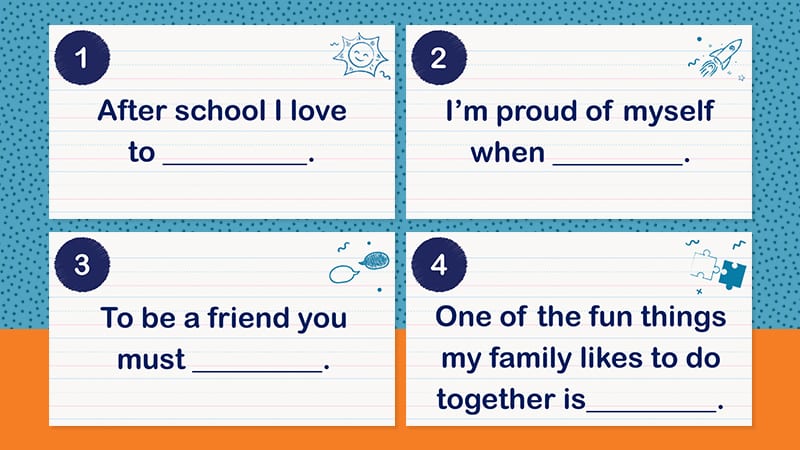
First graders have lots of big ideas and opinions, but they are still learning how to put letters and words together in order to communicate in writing. Help spark their imaginations and get them writing with these 25 first grade writing prompts.
The following writing prompts are designed to spark your first grader’s imaginations and get them writing! And they are perfect for in-person or virtual learning.
(Want this entire set in one easy document? Get your free PowerPoint bundle by submitting your email here, so you’ll always have the challenges available!)
1. After school I love to_______.
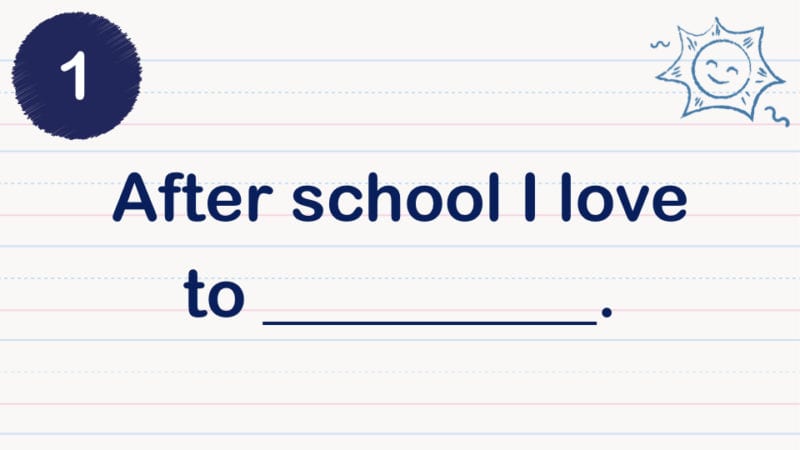
2. I’m proud of myself when_____.
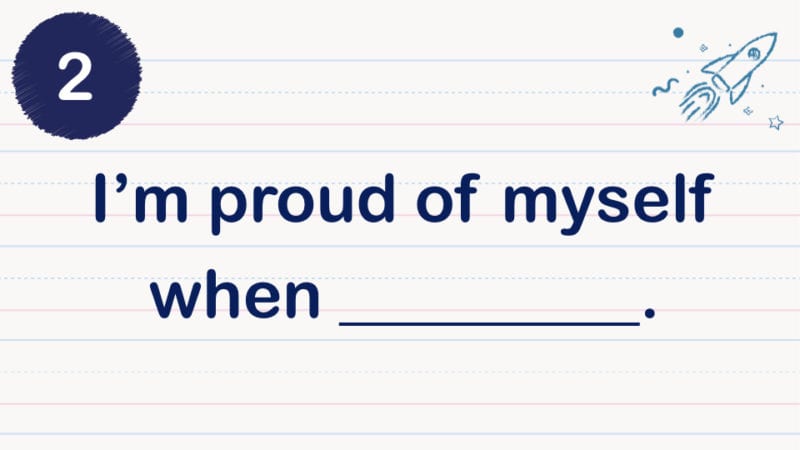
3. To be a friend you must_____.
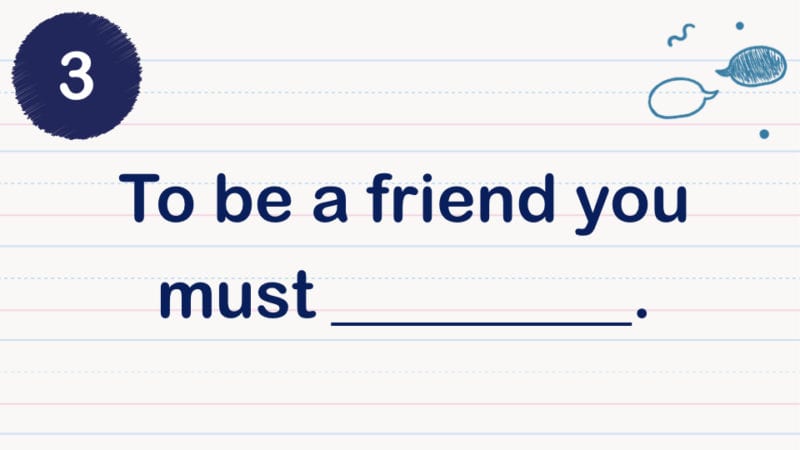
4. One of the fun things my family likes to do together is _____.
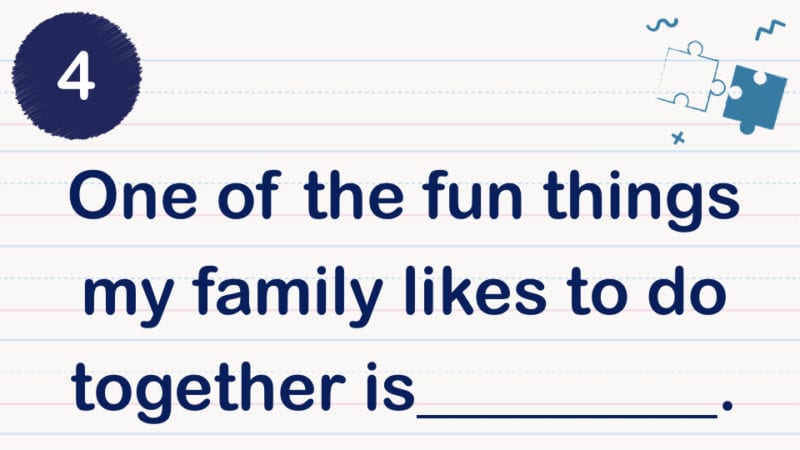
5. Would you rather fly like a bird or swim like a shark? Why?
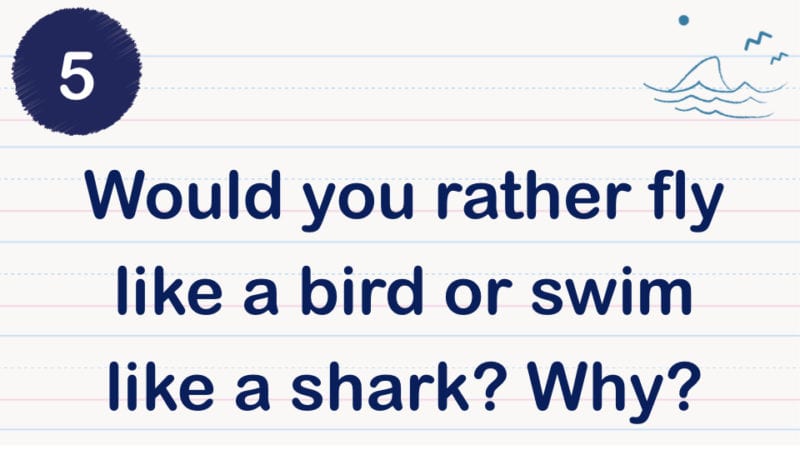
6. If you had three wishes, what would you wish for?
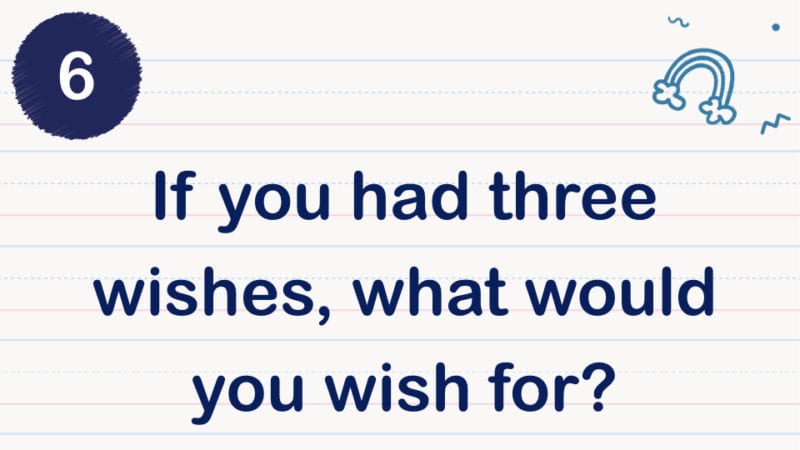
7. What would you put in a treasure chest?
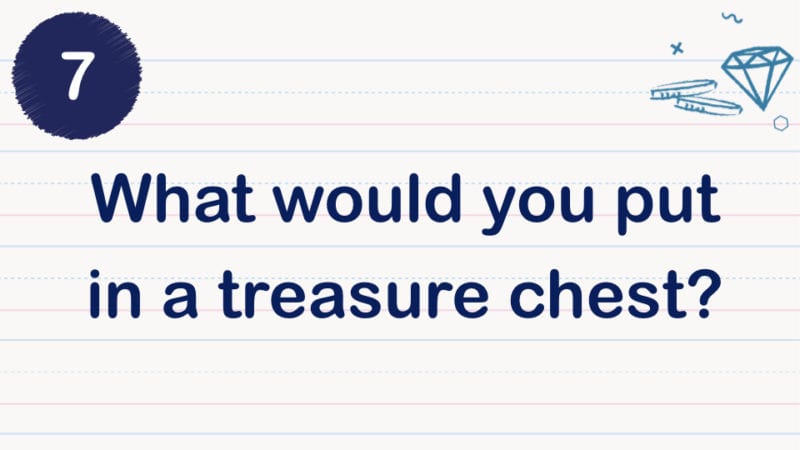
8. This is how you make a sandwich.
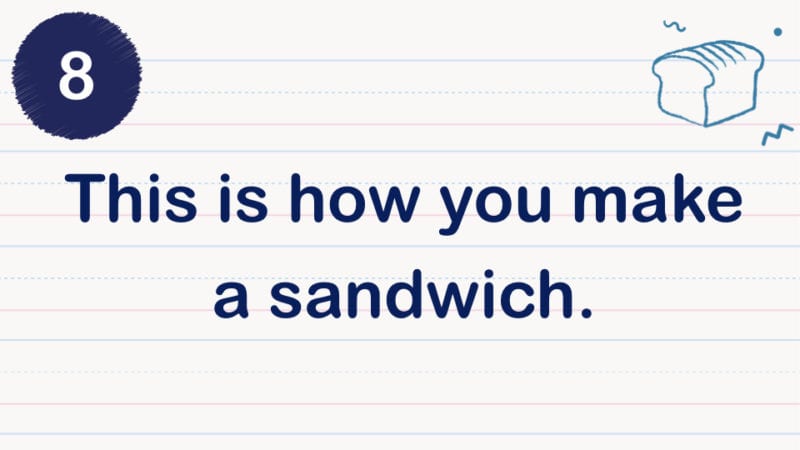
9. If I were as tiny as an ant, I would ______.
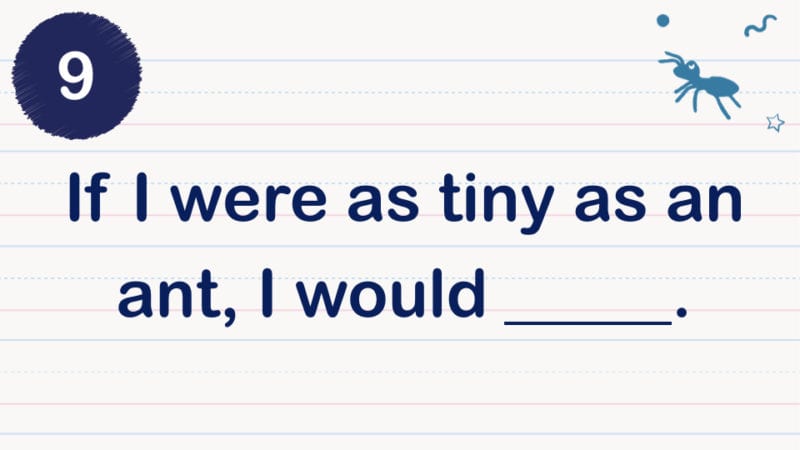
10. My favorite color is ____ because_____.
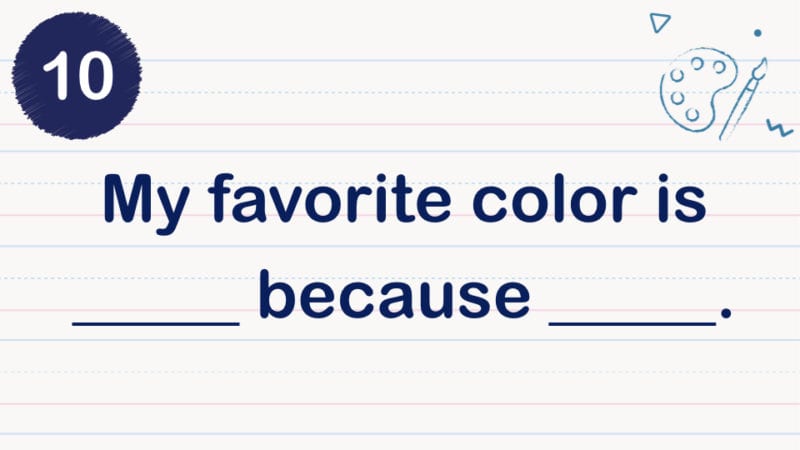
11. I’m excited to learn about _____.
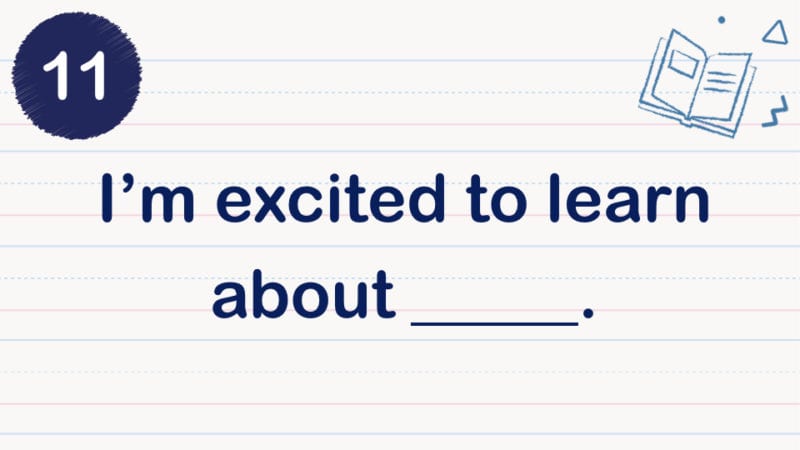
12. Who is the funniest person you know?
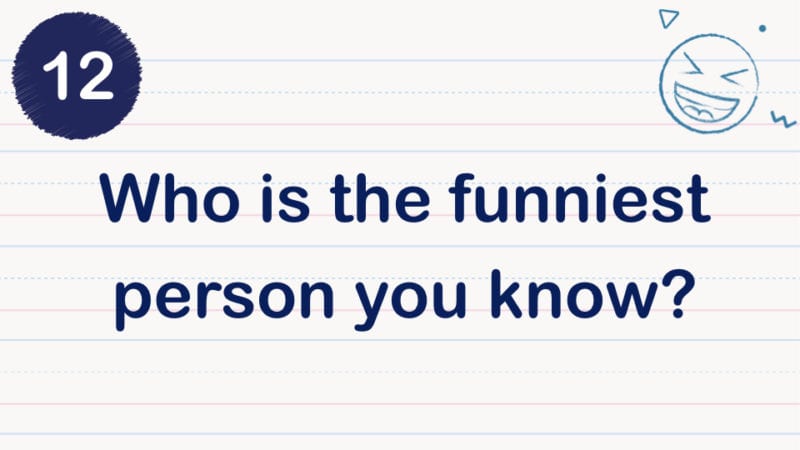
13. If I could fly, I would go_____.
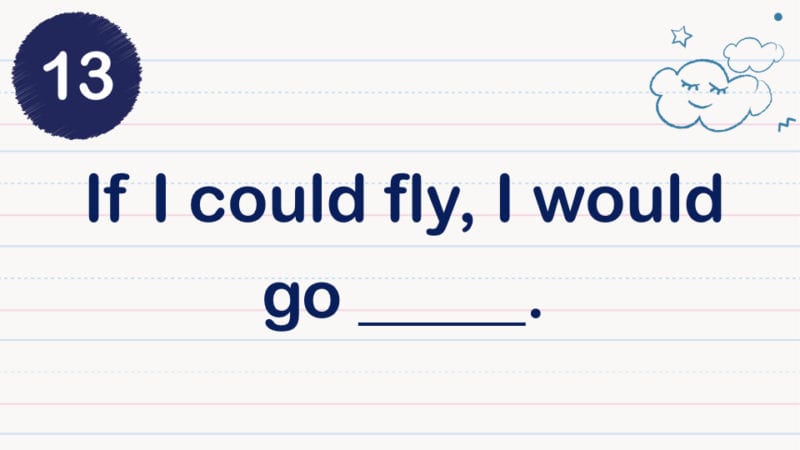
14. My favorite thing to do on the playground is_____.
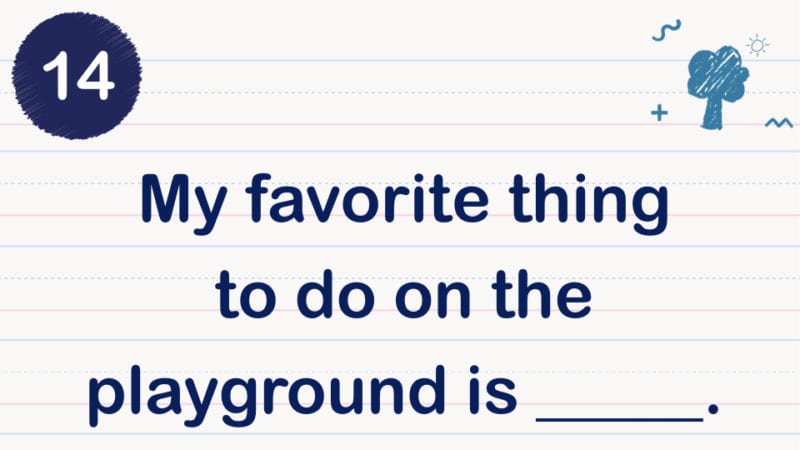
15. I’m really good at_____.
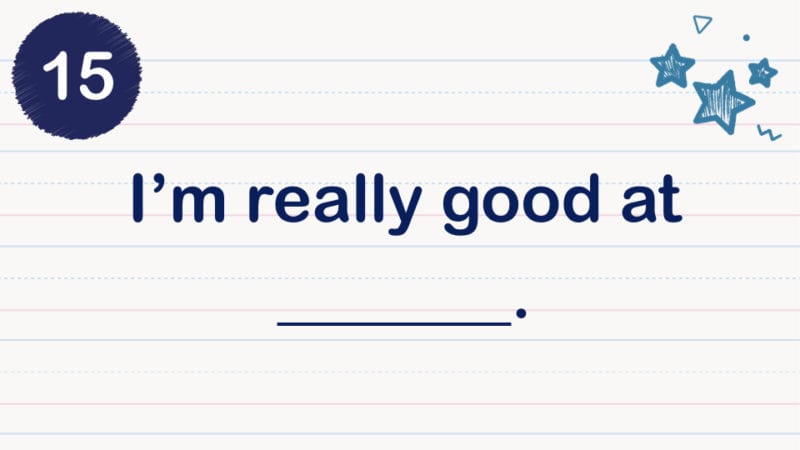
16. Listening is really important because_____.
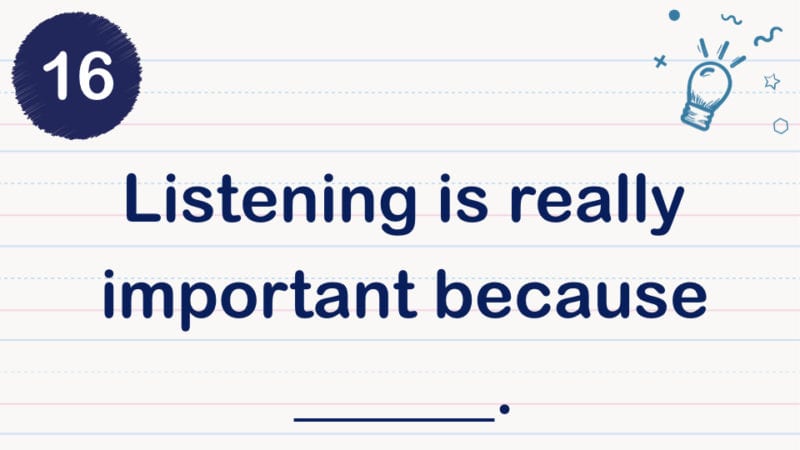
17. When a friend is sad how can you help them feel better?
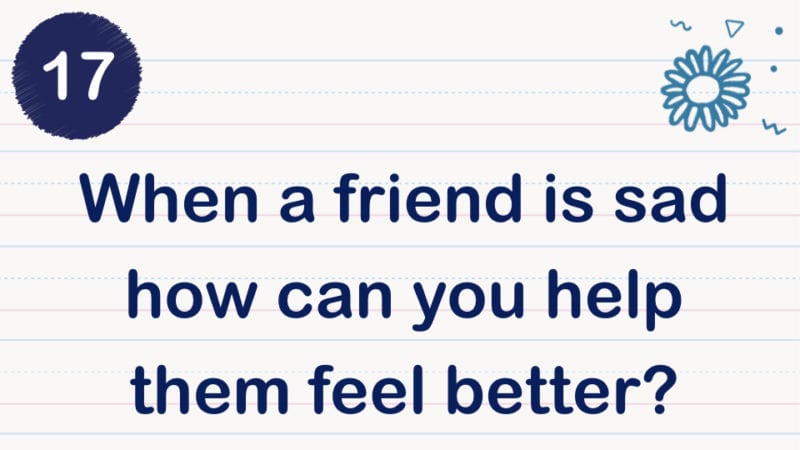
18. List five things you know about bugs.
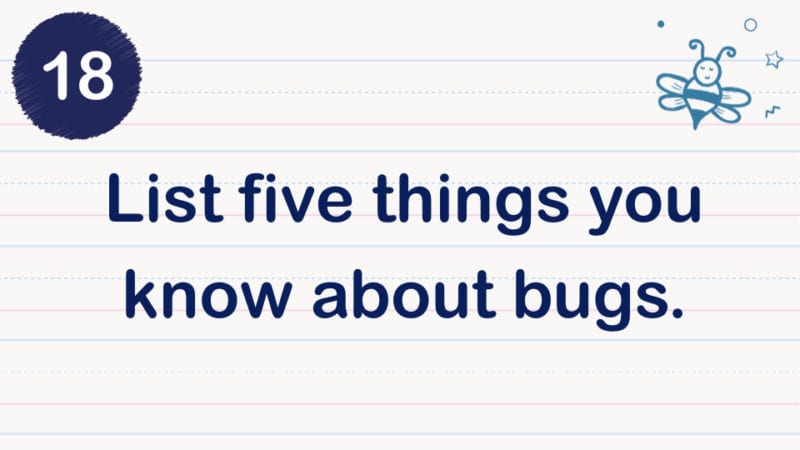
19. What is your favorite sport? Why?
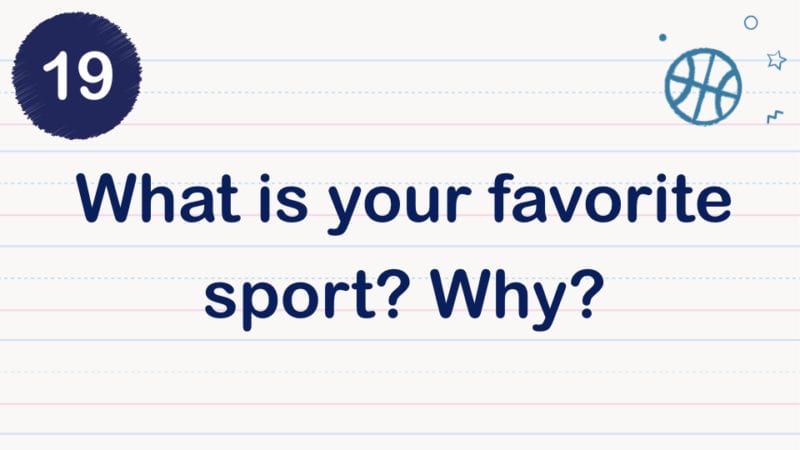
20. I like to read books about_____.
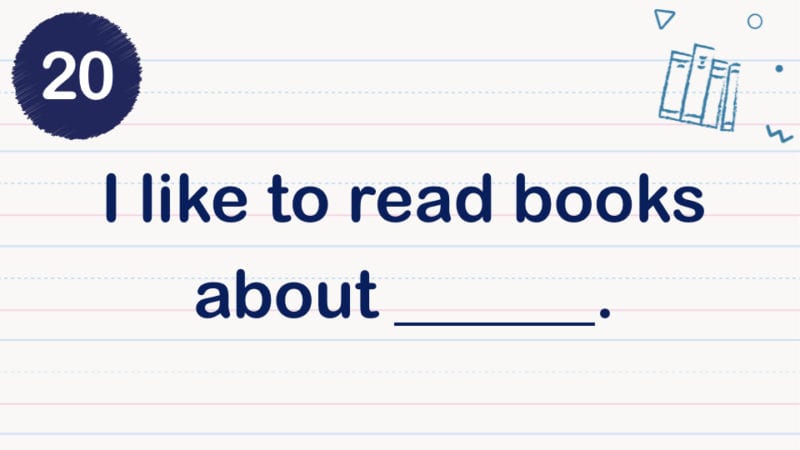
21. My favorite art activity is_____.
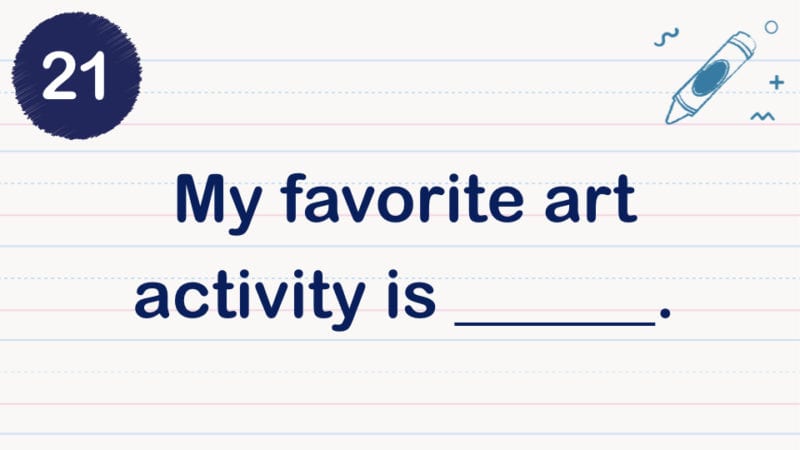
22. One thing I find very interesting is_____.
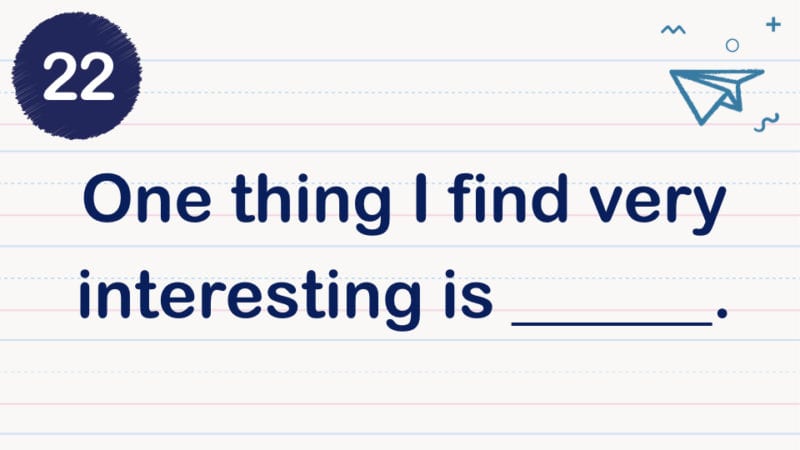
23. I am different because_____.
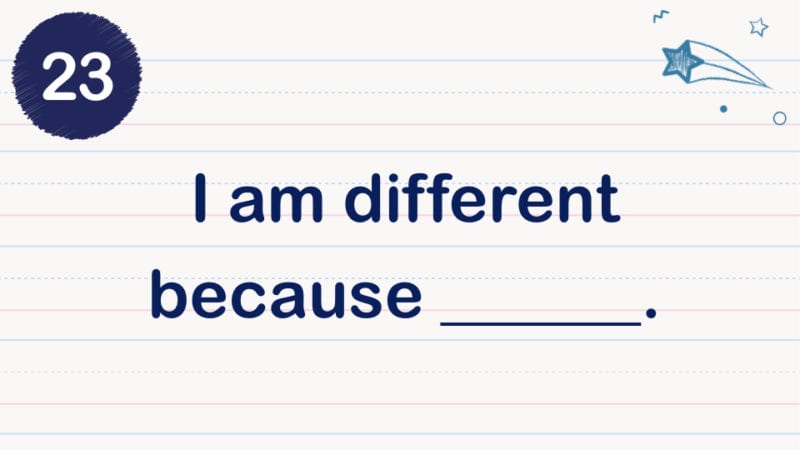
24. When I am by myself I like to_____.
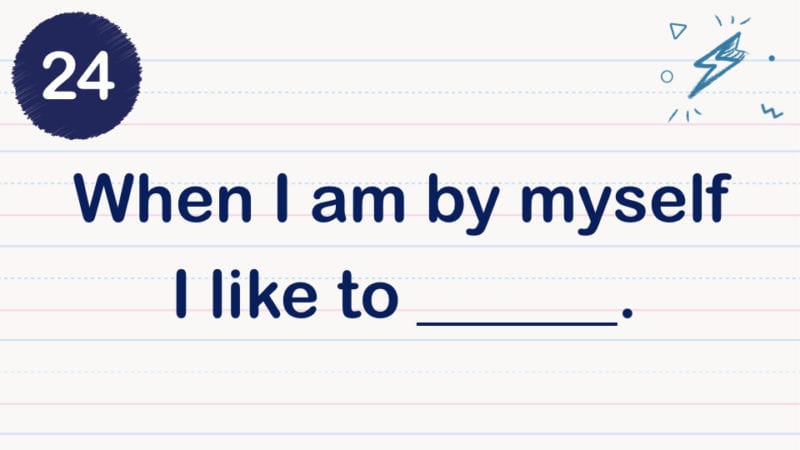
25. What are three things you do before you go to bed at night?
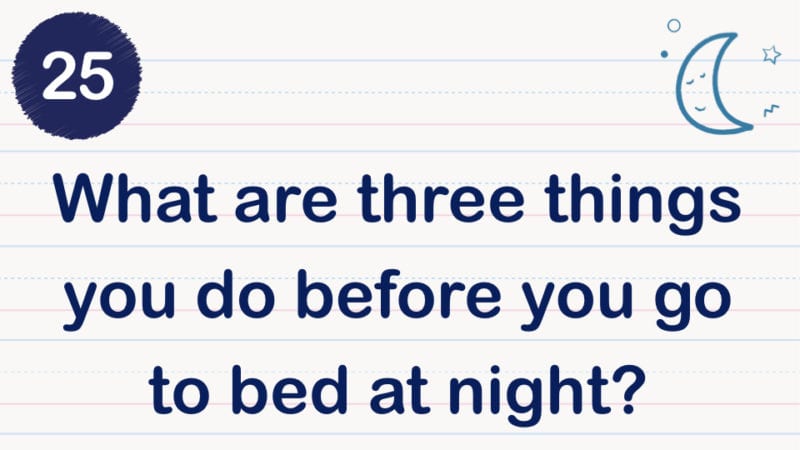
Get My First Grade Writing Prompts
Love these first grade writing prompts? Make sure to check out our first grade jokes to start the day !
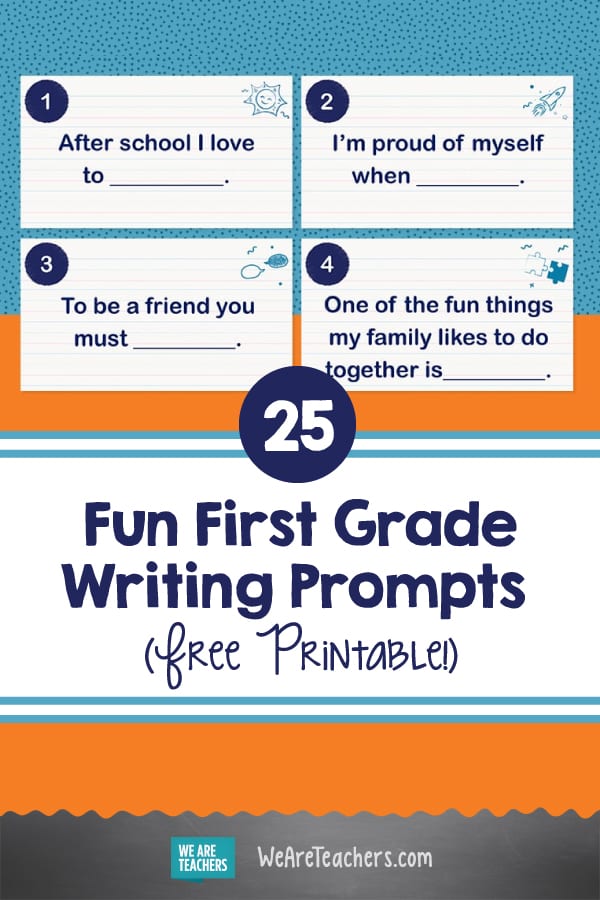
You Might Also Like
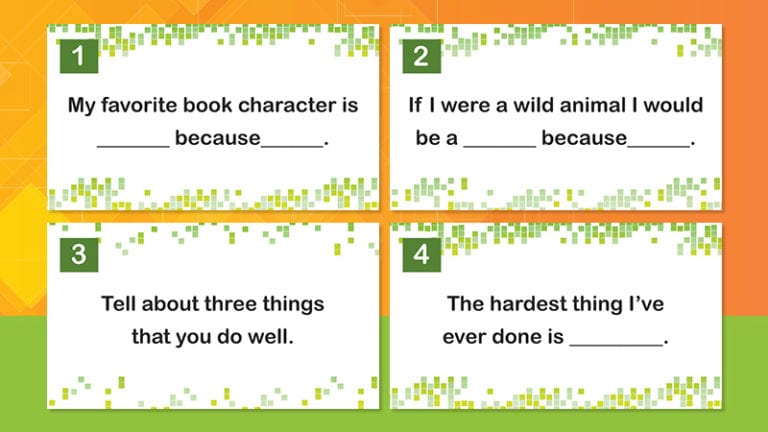
25 Inspiring Second Grade Writing Prompts (Free Printable!)
When my friend is sad, I can help by _____. Continue Reading
Copyright © 2024. All rights reserved. 5335 Gate Parkway, Jacksonville, FL 32256

- Math for Kids
- Parenting Resources
- ELA for Kids
- Teaching Resources

How to Teach Number Recognition to Kids in 8 Easy Steps
How to Teach One to One Correspondence To Kids: 4 Easy Steps
How to Teach Odd and Even Numbers in 4 Easy Steps
How to Teach Long Division to Kids in 6 Easy Steps
15 Famous Mathematicians in History That Kids Should Know
How to Prepare a Schedule for Kindergarten With Examples
How to Prepare a Schedule for Preschoolers With Sample
12 Best Funny Short Stories for Kids to Read in 2024
6 Best Alternatives to Public Schooling: A Guide for Parents
How to Cope With Test Anxiety in 12 Easy Ways
List of 58 Best R Words for Kids in 2024
List of 180 Animal Names in English for Kids
How to Teach Pronouns to Beginners in 6 Easy Steps
12 Best Spelling Apps For Kids in 2024
How to Teach Parts of Speech: 15 Fun Ways for Kids
13 Best Assessment Tools for Teachers in 2024
12 Best STEM Programs for Kids in 2024
12 Best Tips for Substitute Teachers
30 Best Classroom Reward Ideas for Elementary Students
12 Best Websites for English Teachers

100 Fun Writing Prompts for 1st Grade: Journal Prompts

- Narrative Writing Prompts
- Informative Essay Writing Prompts
- Research Writing Prompts
- Funny Writing Prompts
- Self-writing Prompts
- Fiction Writing Prompts
- Animal Writing Prompts
- Journal Writing Prompts For 1st Graders
- Descriptive Writing Prompts
Writing prompts are important tools that parents can use when they want to improve their child’s inherent abilities. The right 1st grade writing prompts can help your kids improve their writing, reading, comprehension, and visual processing abilities.
By having prompts of different themes, styles, and objectives, you can diversify the way that your child approaches writing. You can also enhance their divergent thinking abilities with the right writing prompts. Let’s start with our list of the 100 best writing prompts for 1 st graders.
SplashLearn: Most Comprehensive Learning Program for PreK-5

SplashLearn inspires lifelong curiosity with its game-based PreK-5 learning program loved by over 40 million children. With over 4,000 fun games and activities, it’s the perfect balance of learning and play for your little one.
Here are more educational resources for your first grader so that they never stop practicing!
10 Narrative Writing Prompts

Narratives can be powerful teaching tools to help kids understand the importance of sequencing in writing. They can practice the core skills of narration, including storytelling, plot design, and conclusion. The best narrative-driven 1st grade journal prompts can help kids refine their writing capabilities. You can use these 1st grade narrative writing prompts to help your young ones develop their storytelling.
1. What if you had a magical wand? What would you do with it?
2. What are your favorite after-school activities?
3. Describe a time when you felt lost. What did you do? How did you feel?
4. What superpower would you love to have the most?
5. What are your favorite things about being in the 1 st grade?
6. Describe a difficult time in your life when you had to face some form of adversity.
7. What is your best memory from a vacation that you took with your family?
8. If you could meet one cartoon character in real life, who would it be?
9. Describe your favorite animal. What are its characteristics?
10. What is your favorite holiday? Why do you love that time of the year?
10 Informative Essay Writing Prompts

Informative prompts help kids understand the value of being accurate, precise, and descriptive. You can have them talk about events, historical figures, and facts in greater detail with the right informative prompts.
1. Write an informative essay about animated movies for kids .
2. Pick any stationery item from school. Write about the importance of using that tool.
3. Talk about why it is important to consume healthy foods. Why are vegetables good for us?
4. Talk about how you would teach a special skill to someone you’ve never met.
5. Talk about your favorite hobbies. Why do you enjoy participating in them?
6. Think about what you want to be when you grow up. Talk about your plan on how you’re going to achieve it.
7. Explain in detail why reading is important for all 1 st grade kids.
8. Talk about a time when you failed at something. How did you get back up and succeed?
9. What do you like the most about your best friend? Why is your friendship so special?
10. Select a food item that you love eating, and talk about why it is your favorite.
10 Research Writing Prompts

Research writing is an innovative way of instilling the right work ethic in kids at an early age. You can have your kids practice reviewing, researching, and fact-checking when they prepare their writing prompts. The best 1st grade writing prompts are research-driven ones that require extensive analysis and reviewing.
1. Talk about the origin of alligators.
2. What is the lifecycle of a butterfly? Write about all major stages.
3. What is germination? Write about the process of germination.
4. Why does the earth have oceans?
5. Why does an elephant have large tuskers?
6. Write down five facts about your favorite teacher.
7. Research your family history. What are some interesting facts that you could find?
8. Find ten facts about your city and what makes the city special.
9. What is a biome? Why do we have biomes?
10. What does an ant eat? Describe its journey.
10 Funny Writing Prompts

Funny 1st grade writing prompts can be hilarious to work on, giving younger kids a chance to develop their humor. You can have them imagine funny scenarios and come up with jokes that are in the form of long paragraphs. You can talk to them about the idea of a premise, a funny line, and a storytelling joke for kids .
1. Imagine a world where every house is a gingerbread house. What would your living room look like?
2. Write a funny story about going to space and meeting an alien.
3. Write an adventure short story about saving your friend from ghosts.
4. Write a funny story about futuristic methods of transportation.
5. Imagine that you’re permanently stuck on a ship. What would your life be like?
6. Write a story about what would happen if you woke up in a dog’s body.
7. Write a story about diving into the deepest ocean in the world.
8. If you could have one superpower, what would it be?
9. What would you do if you had a tiger as a pet?
10. You have just invented a translation machine to talk to animals. What would you say first?
10 Self-writing Prompts
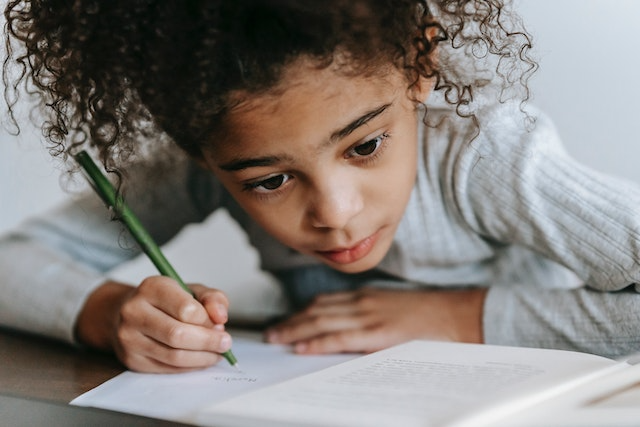
Poems for kids can be an excellent form of self-expression. You can introduce poetic 1st grade writing prompts and have your little ones practice their creative thinking skills. Poems can also empower kids to sound letters and words, which helps in cementing phonics and other concepts.
1. Write a poem about your favorite animals.
2. Talk about your day, but in the form of a poem. Make it rhyme to AABB.
3. Create a poem about the spring season.
4. Write a Haiku about the sky.
5. Create a Limerick about how much you love dancing.
6. Write a poem about the tiniest things in the universe.
7. Can you write a poem about words that don’t rhyme? Try it!
8. Write a poem about the letters of the alphabet.
9. Write a short poem about how much you love your family.
10. Write a poem about counting fruit, vegetables, or marbles.
10 Fiction Writing Prompts

Fiction-based 1st grade writing prompts are also amazing writing tools that can help your child access new areas of their creative thinking. You can help them uncover their true writing potential and improve their problem-solving skills with the right fiction-themed 1st grade writing prompts.
1. You’re suddenly thrust into a game of Island survival and are tasked with saving the people. What would you do?
2. On your next fishing trip, you spot a deep-sea monster. Describe it in detail.
3. You suddenly have wings and are able to fly freely through the sky. Where do you go first?
4. You just slipped on a banana peel and made a mess. How do you clean it up?
5. You left for school and realized that all the streets are made of candy. What happens next?
6. You met Santa’s reindeer in the spring. What kind of questions would you ask it?
7. There are dinosaurs everywhere, and they’re taking control of the city. What happens next?
8. You’re a time traveler and you decided to visit ancient Egypt. What do you see?
9. Start a fairy tale and complete it with the prompt – “There was once a fire-breathing dragon protecting middle earth.”
10. You’re asked to write a completely new language. What would it sound like?
10 Animal Writing Prompts

Animal-themed 1st grade writing prompts can bring a sense of joy back into practicing writing. Your kids can explore the depths of their imagination with prompts about different habitats and species. With the right animal-based 1st grade writing prompts, you can also improve their visual processing capabilities.
1. What is your favorite animal in the whole wide world? Why?
2. Describe your last visit to a petting zoo.
3. If you met a talking cat, what would it say?
4. Which dog breed do you love the most?
5. I love dogs because they are _.
6. What magical animal would you like to meet and why? (Unicorn, dragon, etc.)
7. If you could pick up three animal traits, what would they be?
8. Think of a completely new imaginary animal. What would it look like?
9. Who’s the scariest animal in the jungle?
10. What kind of animal makes the best pet? Why?
10 Prompts to Help Your Kids Understand and Appreciate Emotions

Some of the most impactful 1st grade journal prompts focus on writing about emotions. While opinion writing prompts 1st grade questions are great, you can really get into the mental framework of a child with emotion-driven prompts.
1. When was the last time you were brave?
2. How do you feel when you goof up? Do you feel angry or sad?
3. What I love about myself is _.
4. What makes me happy is when I am _.
5. How do you comfort a friend who is feeling scared?
6. Recall the last time you burst out laughing. How did you feel?
7. Sometimes I feel sad about _.
8. If I could change one thing in the world, it would be _.
9. Sometimes I am hard on myself about _.
10. Something I wish I were better at is _.
10 Journal Writing Prompts For 1st Graders
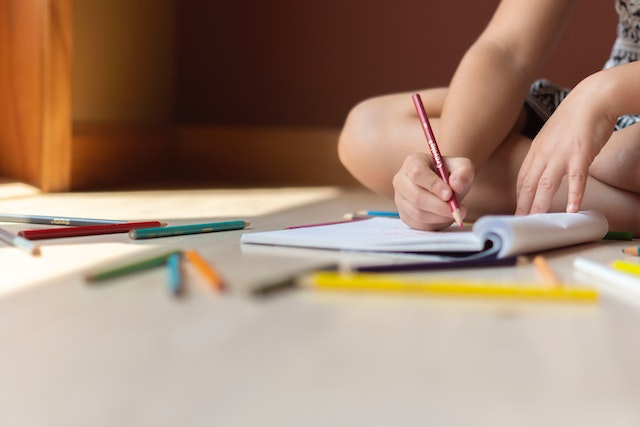
The best first grade journal prompts are the ones that involve introspection, critical thinking, and active recalling. You can improve their writing and comprehension skills with some fun writing prompts for 1st grade students.
1. How are you feeling today? Talk about what emotions you felt.
2. What are five things that you are grateful for?
3. What is the one thing that surprised you today?
4. I love my mom because she’s _.
5. My idea of a fun vacation is.
6. If I lived on a mountain, my daily routine would be.
7. This spring season, I plan on doing _.
8. I love my sibling because _.
9. Write about your last vacation.
10. My favorite day of the year is.
10 Descriptive Writing Prompts
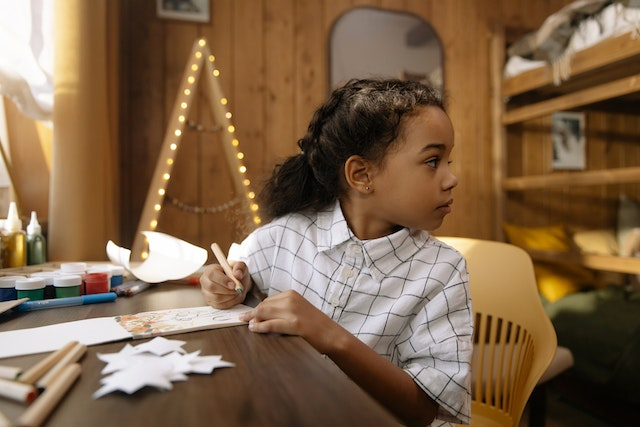
When it comes to writing topics for 1st graders, descriptive ones are some of the most fun for little kids. The top writing ideas for 1st grade students can involve describing events, objects, narratives, and storylines, giving them more control on their vision for their answers. You can use these creative writing prompts 1st grade level questions at any time during the year.
1. Describe a dream walk through a garden.
2. Describe a typical school day in detail.
3. What type of music makes you happy? Describe why you love your favorite artist.
4. Describe the most interesting birthday you’ve had.
5. What’s your favorite hobby? Describe it in detail.
6. How would you describe a smartphone to someone from 1920?
7. What’s your favorite dessert? Why do you love it so much?
8. Which is your favorite memory in the whole wide world?
9. Talk about someone you look up to in detail.
10. Is there a comic book hero you love? Describe their qualities and what makes them special.
Quick Tips on Helping Your 1st Grader Improve Their Writing Skills

Now that we’ve explored the best writing prompts for 1 st graders, you can help them become better at the craft with the right strategies. You can use the best 1st grade journal prompts and encourage your kids to write with clarity and purpose.
You should also use different types of writing prompts for 1st grade kids. This will help you keep things interesting for your little ones while making them feel joyful when writing. In fact, the best 1st grade journal topics are the ones that are within your kids’ realm of interest.
Additionally, you can continue to reward them for writing extensively. By giving them toys, books, and colorful stationery, you can subtly encourage them to continue improving their writing and comprehension at the 1 st grade level.
Start With The Best Prompts That Appeal to Your Kids

You can start by mixing around writing prompts for your kids with different styles. You can also prepare your own prompts by referencing the examples mentioned above. The best way to get your kids excited about writing is to give them prompts that make them think outside the box.
So, what are you waiting for? Get your kids writing engaging narratives with these amazing writing prompts!
Frequently Asked Questions (FAQs)
How do i select the right writing prompts for my 1st grader.
You should start with topics that they enjoy talking about organically.
How do I improve participation and excitement for writing prompts?
You can have them write about their favorite cartoons, movies, and books during the initial stages of writing prompts.
What are some ways to improve my child’s writing?
You can use prompts, worksheets, and tracing sheets, to help your kids improve their writing.
What are some writing activities for 1st graders?
You can have them write letters, poems, stories, and other narrative-driven pieces.
12 Best Social Skills Activities for Kids of All Ages
12 Best Pattern Activities for Preschoolers in 2024
15 Best Movement Activities for Preschoolers in 2024
- Pre-Kindergarten
- Kindergarten
Most Popular

76 Best Report Card Comments Samples for Teachers

117 Best Riddles for Kids (With Answers)

40 Best Good Vibes Quotes to Brighten Your Day
Recent posts.

40 Best Scavenger Hunt Riddles For Kids [With Answers]

How to Teach One to One Correspondence To Kids: 4 Easy...
Math & ela | prek to grade 5, kids see fun., you see real learning outcomes..
Watch your kids fall in love with math & reading through our scientifically designed curriculum.
Parents, try for free Teachers, use for free

- Games for Kids
- Worksheets for Kids
- Math Worksheets
- ELA Worksheets
- Math Vocabulary
- Number Games
- Addition Games
- Subtraction Games
- Multiplication Games
- Division Games
- Addition Worksheets
- Subtraction Worksheets
- Multiplication Worksheets
- Division Worksheets
- Times Tables Worksheets
- Reading Games
- Writing Games
- Phonics Games
- Sight Words Games
- Letter Tracing Games
- Reading Worksheets
- Writing Worksheets
- Phonics Worksheets
- Sight Words Worksheets
- Letter Tracing Worksheets
- Prime Number
- Order of Operations
- Long multiplication
- Place value
- Parallelogram
- SplashLearn Success Stories
- SplashLearn Apps
- [email protected]
© Copyright - SplashLearn

Make study-time fun with 14,000+ games & activities, 450+ lesson plans, and more—free forever.
Parents, Try for Free Teachers, Use for Free

25 Wonderful Writing Prompts for First Graders
The journey of a young writer begins with a single spark of imagination.
As adults, we know the magic that words can bring to our lives, and fostering this magic in children is a gift that lasts a lifetime.
First graders are at an age where their minds are curious, their hearts are open, and their creativity knows no bounds.
This is the perfect time to introduce them to the joy of writing through carefully crafted prompts that ignite their imagination and encourage them to put pen to paper – or fingers to keyboard – and embark on exciting literary adventures.
Now, we’ll explore the enchanting world of writing prompts for first graders, designed to unlock their creativity, expand their vocabulary, and nurture their storytelling skills.
So, let’s dive into the realm of imagination and see how these prompts can light up the writing journey for our young wordsmiths.
Imaginative Story Starters:

Give each first grader a colorful picture or a simple drawing and ask them to come up with a story based on what they see. Encourage them to use their imagination to describe characters, settings, and events. For instance, you could show them a picture of a magical forest and prompt them to write about an adventure that takes place there. This activity not only sparks creativity but also helps develop their descriptive writing skills.
Favorite Animal Adventures:

Children in first grade often have a fascination with animals. Provide them with a list of different animals and ask them to pick one. Then, give them a writing prompt like, “If I were a [chosen animal], I would…” This exercise encourages them to think from a different perspective and helps improve their ability to express ideas in a structured manner.
My Perfect Day:
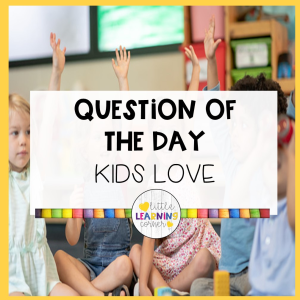
Prompt the first graders to think about their ideal day. Ask questions like, “What would you do from the moment you wake up until you go to bed?” Encourage them to describe their activities, feelings, and any special events that might occur during this perfect day. This activity helps them practice sequential writing and express their thoughts coherently. Related: 20 Amusing Number 2 Activities for Preschoolers
Letter to a Fictional Character:

Choose a popular character from a children’s book or show and have the first graders write a letter to that character. They can ask questions, share their own experiences, or even offer advice. For instance, they could write a letter to their favorite superhero, describing why they admire them and how they would spend a day together. This activity not only enhances their writing skills but also their ability to empathize with fictional characters.
Describe an Adventure:

Present the first graders with a scenario, such as “You found a treasure map in your backyard.” Ask them to write a short description of the adventure they would have while following the map. Encourage them to include details like the landmarks they would encounter, the challenges they might face, and the ultimate discovery. This activity fosters creativity and helps them practice organizing their thoughts in a logical sequence.
Invent a New Planet:

Encourage first graders to let their imagination run wild by asking them to invent a new planet. Provide them with a template where they can name their planet, describe its features, and even draw what it might look like. Prompt them to think about the inhabitants, the landscape, and any special powers or magical elements. This activity promotes creative thinking and helps them practice descriptive writing.
What’s in the Mystery Box?

Present each student with a “mystery box” (real or imaginary) and ask them to write a story about what could be inside. The box could be anything from a magical object to a time-traveling device. Encourage them to think about the box’s history, how it was discovered, and the adventures it might lead to. This activity sparks curiosity and aids in developing narrative writing skills. Related: 20 Counting Activities for Preschoolers & Kindergarten
All About My Family:

Have the first graders write about their families using prompts like “My mom is…” or “My dad likes to…” Encourage them to write a few sentences for each family member, describing their personalities, hobbies, and what they enjoy doing together. This activity not only improves their writing skills but also fosters a sense of connection and belonging.
Create a Comic Strip:

Introduce the concept of comic strips to the first graders and provide them with a template containing a few empty panels. Give them a simple scenario or idea, like “A day at the park,” and ask them to create a comic strip using pictures and short sentences to tell the story. This activity combines visual elements with writing, allowing them to experiment with both mediums.
A Day in the Life of a Superhero:

Invite the first graders to imagine themselves as superheroes for a day. Have them write a story about their superhero alter ego and the adventures they would have. Encourage them to describe their powers, costume, and the challenges they would face while saving the day. This activity nurtures creativity and helps them practice using descriptive language to bring their imaginative ideas to life.
Describe Your Dream Treehouse:

Ask the first graders to imagine their ideal treehouse and write a description of it. Prompt them to think about how it looks, what rooms it has, and what fun activities they could do in their treehouse. Encourage them to use descriptive words to paint a vivid picture of their dream hideaway.
Interview a Favorite Animal:

Invite the students to choose their favorite animal and pretend to interview it. Provide questions like “What’s your favorite food?” or “Where do you like to play?” Encourage them to write the animal’s responses in the first person, sparking their imagination and helping them practice dialogue writing.
Time Travel Adventure:

Present the first graders with a time travel scenario, such as “If I could travel back in time to any place, I would go to…” Ask them to describe the time period they would visit, the people they would meet, and the adventures they would have. This activity combines historical imagination with narrative writing skills.
Create a Mini Recipe Book:

Introduce the concept of recipes to the first graders by having them create a mini recipe book. Provide prompts like “My favorite snack” or “A magical potion recipe.” Encourage them to write down the ingredients and steps in a clear and organized manner. This activity not only develops writing skills but also introduces basic instructions.
My Secret Superpower:

Encourage the first graders to imagine a unique superpower they wish they had, such as flying, invisibility, or talking to animals. Have them write a story about a day when they discovered and used this superpower. Encourage them to include details about how they felt, the situations they encountered, and how they used their power to help others.
The Magic Door:

Ask the first graders to imagine they have found a magical door that can take them anywhere they want. Have them write a story about where they would go and what adventures they would have. Encourage them to use their creativity to describe the new places they discover.
My Favorite Season:

Prompt the students to write about their favorite season. Ask them to describe the weather, activities, and things they enjoy during that season. Encourage them to use descriptive language to capture the essence of their chosen time of year.
If I Were a Robot:
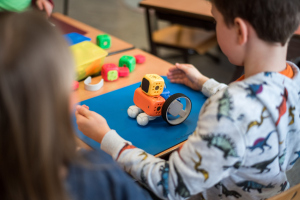
Encourage the first graders to imagine they are robots for a day. Have them write a story about what they would do, how they would move, and the tasks they would complete. This imaginative activity helps them explore different perspectives and develop their storytelling skills.
My Dream Adventure:

Ask the students to think about an adventure they’ve always wanted to go on. It could be a trip to the moon, exploring the deep sea, or visiting a magical land. Have them write a story detailing their dream adventure, including the sights they would see and the experiences they would have.
A Talking Animal Friend:
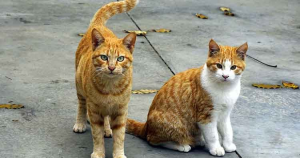
Encourage the first graders to write a story about a day when they meet a talking animal friend. It could be a chatty cat, a chatty dog, or any other animal they like. Have them describe the conversations they have and the fun activities they do together.
The Enchanted Forest:

Invite the first graders to imagine they have stumbled upon an enchanted forest. Ask them to write a story about their adventure in the forest, describing the magical creatures they meet, the mysterious places they explore, and the challenges they overcome.
My Special Pet:

Prompt the students to create a story about a special pet they would like to have. Encourage them to describe the pet’s appearance, personality, and the activities they would do together. This activity allows them to practice using descriptive language and develop their storytelling abilities.
If I Lived in a Castle:

Encourage the students to imagine they live in a grand castle. Have them write a story about their daily life as a castle resident, including the rooms they would have, the activities they would engage in, and the adventures they would go on within the castle’s walls.
The Day the Toys Came to Life:

Prompt the first graders to write a story about a day when their toys magically come to life. Encourage them to describe the activities they enjoy with their animated toys, the conversations they have, and the imaginative scenarios that unfold. Related: 20 Fun Rhyming Activities for Preschool & Kindergarten
Recommended:
- 24 Fun Small Group Activities for Preschoolers
- 22 Polar Bear Art & Craft for Preschoolers
- 25 Amazing Technology Activities for Preschoolers

Sohaib Hasan Shah
Sohaib's journey includes 10+ years of teaching and counseling experience at BCSS School in elementary and middle schools, coupled with a BBA (Hons) with a minor in Educational Psychology from Curtin University (Australia) . In his free time, he cherishes quality moments with his family, reveling in the joys and challenges of parenthood. His three daughters have not only enriched his personal life but also deepened his understanding of the importance of effective education and communication, spurring him to make a meaningful impact in the world of education.
Leave a Comment Cancel reply
Save my name, email, and website in this browser for the next time I comment.
Creative Writing Topics for 1st Grade with Printables
First grade is a fun and exciting year for a student. It’s a big step up from Kindergarten. The first grade may be the first time a child is in school full day or taking the bus.
First grade is when students are expected to expand and improve on writing skills. Since writing is fairly new to first graders, they need support to get their thoughts and options written clearly and confidently.
Fun writing topics are a great way for first graders to be excited about writing. The writing prompts below were developed to have students get their creative juices flowing. We want students to get their thoughts on paper and enjoy writing while practicing sentence structure and punctuation.
Writing prompts for 1st grade
These writing topics are perfect for first-grade students. There are so many creative writing topics; how do I know these are great for first-grade students?
At Kids Play and Create , we picked simple, fun writing topics perfect for young writers. These writing prompts are designed to be easy to write about, interesting, and not intimidating for first-time writers.
3. What are five reasons kids are cooler than grown-ups?
4. My favorite color is ___________________, because…
5. What time do you think you should go to bed? Why?
6. What is your favorite thing to do at recess? Why?
9. Describe what your favorite dinner is.
How to Writing for First Grade
In first grade, students will learn to write detailed explanations of how to do something. Here are writing topics to encourage students to give detailed instructions on doing something or practice writing a description.
3. Give steps on how to wash your hands.
4. Write three things you did before coming to school.
6. Describe what your mom, dad, or sibling looks like.
7. Janelle has moved here from Florida and has never seen snow. A snowstorm is on the way. Write instructions teaching Janelle how to build a snowman.
8. Write detailed instructions on how to draw a stick figure.
Imaginative Storytelling Writing Prompts for First Grade
2. Today your best friend asked you to go on an exciting adventure; where are you going?
3. You found a magic wand; what will you do with it?
4. A genie granted you three wishes; what are they?
5. Describe the best day ever.
6. Your mom has to say yes to everything today; what do you ask her?
7. You have been the newest Pokemon. Describe what you look like and what your abilities are.
8. Take a look at the clouds; what do you see?
9. You got trapped inside a snow globe; how did you get in there? Did you find your way out?
10. You are at the zoo with your class, and the animals escape; what happens next?
Self-Esteem Writing Topics for First Grade
Free printable worksheets for first-grade students.
Enjoy Free printable worksheets for first-grade students. Teachers can use printable worksheets in addition to classroom materials. These free printable worksheets can be used in the classroom, in an after-school program, in homeschool, or at home for extra practice.
Related Posts
All about me collage self-esteem/character building activity for kids, being thankful activities for kids, thanksgiving activities for kids, feel good notebook self-esteem character building activity for kids, positive notes game self-esteem character building activity for kids, how to get kids to work together, games for kids.
1st Grade Creative Writing Lesson Plans
- Most Popular
- Most Recent
| Add to Folder | |
|---|---|
| creative writing | |
| children's book | |
| activities | |
| classroom tools | |
| language arts and writing | |
| vocabulary |

Miss Giraffe's Class
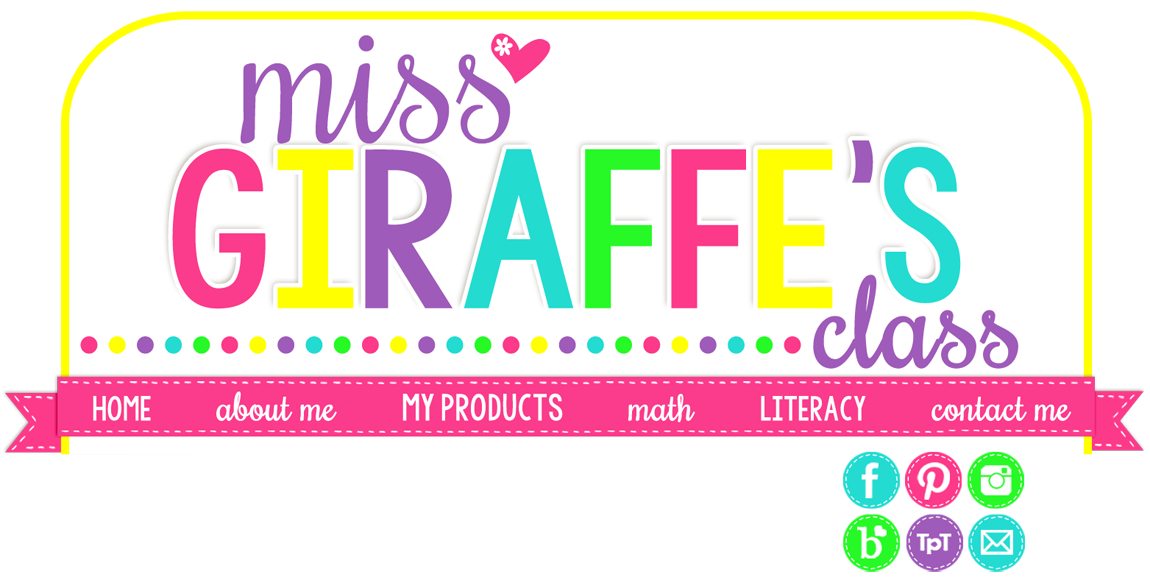
- How to Make Writing Fun for 1st Graders
1. Make writing into a craft activity!

2. Inspire your young writers with a lot of pictures!

3. Remove any frustrations for reluctant writers

4. Let your students write about topics they're interested in!

0 comments:
Post a comment.

FOLLOW ME ON TPT
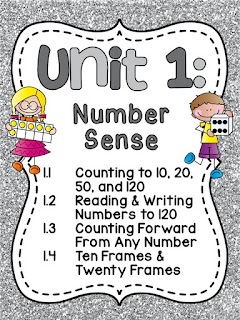

- ► October (1)
- ► May (1)
- ► April (1)
- ► March (1)
- ► February (1)
- ► January (2)
- ► December (2)
- ► November (1)
- ► December (1)
- Free Kindergarten and First Grade Worksheets and A...
- Teaching Singular and Plural Nouns
- Long Vowel Games for First Grade and Kindergarten
- ► July (4)
- ► April (2)
- ► August (4)
- ► June (1)
- ► September (1)
- ► August (1)
- ► March (2)
- ► January (4)
- ► October (2)
- ► September (2)
- ► July (2)
- ► May (2)
- ► April (3)
- ► March (3)
- ► February (2)
- ► November (2)
- ► July (1)
Blog Design by:

Filter Results
- clear all filters
Resource Type
- Guided Lessons
- Lesson Plans
- Hands-on Activities
- Interactive Stories
- Online Exercises
- Printable Workbooks
- Science Projects
- Song Videos
middle-school
- English Learner (EL)
- Fine arts
- Math
- Reading
- Writing Process
- Writing Organization and Structure
- Fiction Writing
- Nonfiction Writing
- Grammar
- Science
- Social emotional
- Social studies
- Common Core
Lesson Plans for First Grade Writing


How to teach writing to Grade 1 kids: New strategies for teachers and parents
Associate Dean (Research), Faculty of Education, Western University
Disclosure statement
Perry Douglas Klein receives funding from The Social Sciences and Humanties Research Council of Canada
Western University provides funding as a member of The Conversation CA-FR.
Western University provides funding as a member of The Conversation CA.
View all partners
Writing is a craft that is vital for both communicating and learning . However, many children struggle to learn to write. For most, their difficulties persist throughout elementary school unless they get help. As recently as 2018, there was very little research on how to teach Grade 1s effectively .
However, recent research shows how teachers can help Grade 1s make a strong start on writing. Parents have a vital role to play in laying a foundation for early writing success.
Many parents have likely heard children say, “I don’t know what to write.” Teaching children strategies for writing tackles this problem head-on.
Breaking writing down into steps
In 2019, a team of Spanish and British researchers published one of the first experiments on teaching writing strategies in Grade 1 . They explored how a child can learn to write a story by asking themselves a series of questions: When did it happen? Where did it happen? Who is the story about? What did they do? What happened? How did it end? These questions help the child to generate and organize their ideas.
To help children remember this writing strategy, teachers in the study used a picture of a mountain with a path that led past six houses — one for each question. The teachers discussed the strategy, modelled how to use it and wrote together with the class. After instruction, the children wrote stories that were higher in quality, longer and more coherent.
Strategies work
The value of teaching writing strategies in Grade 1 has been confirmed by additional studies that examine teaching specific kinds of writing: Procedural writing (instructions for someone on how to do something) , and opinion writing (short essays meant to persuade someone of something) . In this writing research, teachers combined strategy instruction with discussions, picture books and dramatization.
And in our own recent research, we found that strategy instruction is effective for Grade 1 students across the range of writing achievement levels: low, medium and high . These Grade 1 studies join over 100 previous studies with students in higher grades in showing that teaching writing strategies works .

Printing, handwriting, spelling
Recent research also provides renewed support for the seemingly old-fashioned skill of printing. Grade 1s who can print accurately and quickly are able to create better and longer stories and reports . Teaching printing helps students to create better stories . Despite over 70 previous studies on the benefits of teaching printing and cursive writing , systematic teaching and assessment of these skills has declined in some curricula.
Read more: Writing and reading starts with children's hands-on play
Spelling is another traditional skill, the importance of which has been confirmed by recent research. Better spellers create better and longer stories, while poor spellers struggle with composing , and Grade 1 spelling affects the development of composition in later years.
Spelling education works best if it is formal, including, for example, lessons and practice activities . Additionally, teaching writing strategies combined with spelling and printing is more effective than teaching each of these skills alone .
Parents can help children practice spelling at home. Teachers and parents can also show children the “invented spelling” strategy of saying a word slowly, stretching out the sounds, and printing a letter (or letter combinations, such as “th”) for each sound. This will lead to some errors, but in kindergarten and Grade 1, invented spelling is an important driver of spelling development .
New understanding of Grade 1
This new understanding of the importance of Grade 1 is beginning to change writing education . In the past, many schools in Canada and the United States waited for struggling readers and writers to reach the middle elementary grades . Then, they were assessed by a school psychologist. If they were diagnosed with a learning disability, they were placed in a special education class.
However, in a new approach, response to intervention, teachers use evidence-based methods (like strategy instruction) to teach the whole class. They assess students regularly based on their daily writing, and if a child is below grade level, they receive help in a small group .
This approach is not yet common. However, it is almost certainly coming to some provinces in reading education . Reading education and writing education are intertwined, so we can expect the same approach to follow in writing.
Laying the foundations
The foundation for writing success is ideally being supported at home before children start kindergarten.
Parents can ask children to tell them stories, print the stories for them, then read them aloud for the child. They can teach children simple skills like forming letters and printing their name.
Parents can also practice printing with children at home; this is especially valuable for struggling writers . They can help children to write things that are important to them, like birthday cards for family members .
Read more: To help children learn how to read in the pandemic, encourage writing messages as part of play
Parents can also encourage children to read and write independently . Once children begin to write, parents can be their best audience, praising their efforts and the good qualities of their writing, and making suggestions to help with ideas, printing, and spelling .
When children begin school, and into Grade 1, parents can watch for red flags in their child’s writing development. During Grade 1, the average student learns to print the letters of the alphabet legibly and fluently, spell one syllable words the way that they sound (cat, game) and spell common short words that are not spelled the way that they sound (you, they). They also learn to write a story a few sentences in length about a personal experience .
If your child is missing these basic skills, don’t wait and see — talk with your child’s teacher and make a plan to help them succeed.
- Handwriting

Lecturer in Indigenous Health (Identified)

Lecturer in Visual Art

PhD Scholarship

Senior Lecturer, HRM or People Analytics

Centre Director, Transformative Media Technologies
Free Printable Creative Writing Worksheets for 1st Class
Creative Writing: Discover a world of imagination with our free printable Reading & Writing worksheets for Class 1 students. Enhance their skills and spark their creativity with these fun resources.

Explore Creative Writing Worksheets by Grades
- kindergarten
Explore Other Subject Worksheets for class 1
- Social studies
- Social emotional
- Foreign language
- Reading & Writing
Explore printable Creative Writing worksheets for 1st Class
Creative Writing worksheets for Class 1 are an excellent resource for teachers looking to engage their students in the world of fiction writing. These worksheets provide a variety of activities that help students develop their reading and writing skills while fostering a love for storytelling. By incorporating different elements of fiction writing, such as character development, setting, and plot, these worksheets allow young learners to explore their creativity and imagination. Additionally, these Class 1 worksheets focus on improving students' grammar, punctuation, and sentence structure, which are essential components of effective writing. Teachers can utilize these creative writing worksheets to supplement their lesson plans and provide a fun, interactive way for students to practice their reading and writing skills.
Quizizz is a fantastic platform that offers a wide range of educational resources, including Creative Writing worksheets for Class 1, to help teachers enhance their students' learning experience. This platform not only provides engaging and interactive worksheets but also allows teachers to create quizzes and games that can be customized to suit the needs of their students. By incorporating Quizizz into their lesson plans, teachers can effectively track their students' progress in reading and writing, as well as other subjects. The platform's user-friendly interface and extensive library of resources make it an invaluable tool for educators looking to provide their Class 1 students with a comprehensive and enjoyable learning experience. With Quizizz, teachers can ensure that their students develop a strong foundation in fiction writing and other essential skills needed for academic success.

Grade 1 Writing Activities
8 fun grade 1 writing activities.

We’ve compiled a list of seven exciting writing activities to inspire your little ones to get started on their writing journey.
1. Read, Read, Read!
Your first-grade child may have a book that they just love! Why not get them to read it one more time and then write a short paragraph explaining why they love it so much. Which character do they like the most and what would they want to ask them if they met in real life?
Reading is generally a wonderful way to improve writing levels in young children and is especially effective when done on a regular basis! On Night Zookeeper , we love to encourage children to write about what they are reading in an interactive journal called ‘Reading Light’.
2. Get Active, Get Outdoors
A great way to inspire your little ones whilst burning off some excess energy is to get outside with pencils and paper. Before heading out on your adventure, make a chart like the one below:

The great outdoors is the perfect place to get your children using all of their senses. Begin your adventure by asking your child to write down an object that catches their eye in the first column. Then challenge them to describe the sounds they can hear around this object, how it feels and how it smells. Once your chart is complete, find a quiet place to sit with your child and invite them to write a sentence about each object using some of the lovely descriptions that they added to their chart.
3. The Sentence Building Game
Spelling often holds children back from getting started on their writing journey at first-grade level. You can help alleviate this barrier by giving children words they can use to build sentences with.
The idea of this activity is that children use the words provided to make as many sentences as they possibly can. Points can be awarded for each complete sentence that starts with a capital letter and ends with a punctuation mark. Here’s an example of how you could set this up:

4. Get Crafty!
A wonderful way to make writing fun for your child is to combine the writing process with an arts and crafts project.
For example, challenge your children to paint a picture of an animal they love. This could be a pet or an animal they love to visit at the zoo. They could also use magazine clippings and other materials you have at hand to add a layer of collage to their picture. Finally, complete the activity by asking them to write three sentences about why they chose this animal in particular.
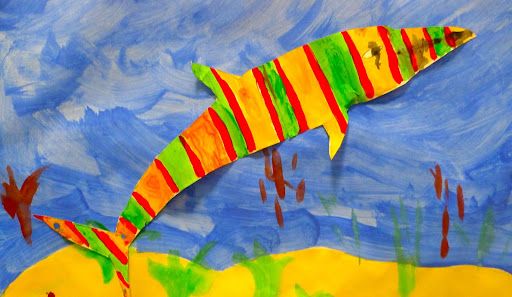
5. The Daily Journal
Keeping a journal is a great way to get your first-grade child writing in small chunks, on a regular basis, about a topic they know better than anyone!
Here’s a format you might like to use:
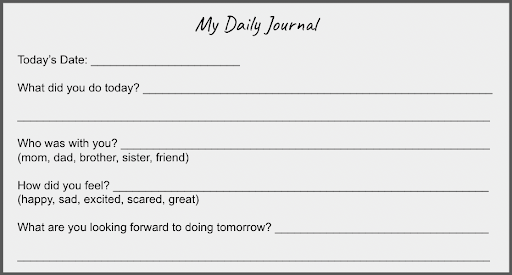
You could even ask your childr to be involved in the template creation process. Ask them which questions they would like to answer on a daily basis and incorporate these into the activity. This will give your child a sense of ownership and a deeper understanding of the activity.
6. The Greeting Card
Ask your child to make a card for a person in their family. This is a wonderful activity to get your children writing whilst also spreading love and joy in the process.
The card could be to celebrate a special occasion such as a birthday or holiday, or it could simply be a card to share their thoughts and feelings with their chosen family member. Children can be encouraged to write as much as they like about this special person, writing down all of their thoughts and feelings.
7. “When I am older, I want to be…”
Plan a special day for your child when they get to dress up as an adult they admire. This could be someone famous that they look up to, or it could simply be a profession that they admire, such as becoming a teacher, pilot or doctor. Set up activities to give your child the opportunity to explain verbally what they would like to be when they grow up and give them time to act as the person they have dressed up as. Towards the end of the day, present them with a template of questions for them to answer in writing. The below template may be helpful, or you can invent your own with your child.
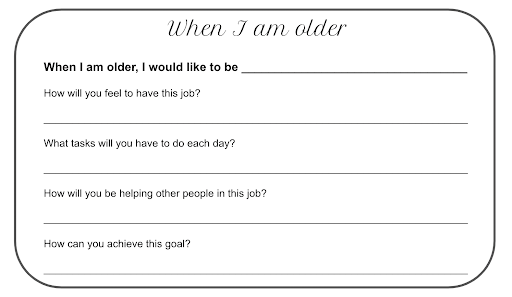
8. Night Zookeeper

Night Zookeeper makes writing fantastically fun for children aged six to twelve!
Our writing program for kids features an array of writing activities, such as prompts, games, and interactive lessons, created to inspire children while keeping them focused and engaged.
Sign up today to get a 7-day FREE trial!
More writing activities & prompts
- Grade 1 Picture Writing Prompts
- Grade 1 Writing Prompts
- Elementary Writing Prompts
- Elementary Writing Activities
Related content
- Elementary Language Arts
- Elementary Writing Curriculum
- Language Arts Resources

Make Reading & Writing Fantastically Fun!
- Award-winning reading & writing program for kids
- Improves spelling, grammar, punctuation & vocabulary
- Over 1,000 different learning games and activities

Creative Writing For Class 1 Format, Examples, Topics, Exercises
Creative writing for Class 1 is an excellent way to introduce young students to the world of storytelling, imagination and self-expression. It is important to foster creativity and encourage students to express themselves in unique ways. Here are some guidelines, examples, topics and exercises to help you teach creative writing to Class 1 students.
Format for Creative Writing in Class 1:
1. Brainstorming: Start the session by asking students to share their ideas and thoughts on the topic given to them. Encourage them to think outside the box and come up with unique and interesting ideas. 2. Storytelling: Once the students have some ideas, encourage them to start writing a story. Provide them with a basic structure or outline, such as an introduction, middle, and conclusion. 3. Illustrations: Ask students to illustrate their stories with drawings or pictures. This will help them to visualize their ideas and bring their stories to life. 4. Sharing: Allow each student to share their story with the class. This will give them an opportunity to practice their public speaking skills and receive feedback from their peers.
Also Read: Creative Writing Topics For Class 4
Examples of Creative Writing For Class 1:
1. Write a story about a magical forest.
Once upon a time, there was a magical forest. The trees were tall and covered in green leaves. The animals that lived in the forest were friendly and happy. One day, a group of children went into the forest to explore. They soon discovered that the forest was full of surprises. They found a tree with a secret door, a pond with talking fish, and a clearing with a giant mushroom. The children had the time of their lives in the magical forest, and they couldn’t wait to come back and explore more.
2. Write a story about a lost puppy.
Once there was a little puppy named Max. Max loved to play and explore, but one day he got lost. He wandered through the streets and tried to find his way back home, but he couldn’t remember the way. Luckily, a kind-hearted boy found Max and took him in. The boy gave Max food, water, and a warm place to sleep. The boy also put up posters and asked around to try to find Max’s owner. After a few days, Max’s owner saw one of the posters and came to pick him up. Max was so happy to be back home, and he never wandered off again.
Topics for Creative Writing for Class 1:
1. My favorite animal 2. A day at the beach 3. My family 4. My favorite food 5. A trip to the zoo 6. A Day in the Park 7. My favorite toy 8. My best friend 9. My favorite book 10. My favorite movie
Exercises for Creative Writing for Class 1:
1. Picture Prompt: Show students a picture and ask them to write a story based on what they see. For example, show a picture of a beach and ask them to write a story about a day at the beach. 2. Story Starters: Provide students with a sentence or two to start their story. For example, “Once upon a time, there was a magical castle…” 3. Word Association: Give students a word and ask them to write a story that includes that word. For example, give them the word “giraffe” and ask them to write a story that includes a giraffe. 4. Collaborative Writing: Ask students to work in pairs or groups to write a story together. This will encourage teamwork and creativity. 5. Character Development: Ask students to create a character and write a story about that character. Encourage them to think about the character’s personality, appearance, and backstory.
Conclusion On Creative Writing For Class 1:
Creative writing is a great way to help Class 1 students develop their imagination and creativity, as well as their writing skills. By providing students with a variety of topics and exercises, you can help them explore their own interests and experiences and encourage them to express themselves in unique ways. It is important to create a positive and supportive environment where students feel comfortable sharing their stories and ideas with their classmates. With practice and encouragement, Class 1 students can become confident and imaginative writers who enjoy the process of creating and sharing their stories.

17 Fun First Day Of School Writing Activities
The smell of freshly painted halls, the excited chatter of returning students bursting with two months’ worth of gossip to share—it must be the first day at school again.
Rusty pens and dusty pencils are hastily pulled from the bottom of school bags where, for many, they’ve lain all summer, ready for back to school.
You’ll need engaging writing activities to get those atrophied writing muscles back in shape. The standard ‘What I Did This Summer’ essay won’t cut it.
Luckily, we have 17 Great Back-to-School Writing Activities for you to help shake off the cobwebs and get your students’ writing skills back on par. Let’s get started.
Ice Breaker
Writing activities.
At the start of each school year, there’s likely to be a new face or two in the class, and while two months isn’t a long time in the grand scheme of things, our students can do a lot of growing and changing in that time.
Ice-breaker writing activities allow students to connect with others in the class. They give students some insight into the lives of their classmates.
Here are some fun ice-breaker writing activities to get the new school year off to a strong start writing-wise.
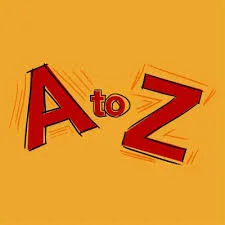
The A to Z of Me! Poem
Students write an acrostic poem about themselves in the A to Z of Me. The poem’s first line starts with the letter A, and each new line begins with the following letter of the alphabet, which should reveal something about the poet.
This may be too long for younger students – it’d be a 26-line poem after all. In this case, you can quickly adapt the activity to employ the letters of the student’s first name.
This activity aims for students to capture the essence of who they are in their poems. They can write a phrase or line based on their interests, appearance, things they have done, hobbies, desires, ideas, where they’re from, etc.
You can make this more challenging for older and stronger students by insisting they employ a rhyme scheme throughout their poems.
For example, they could write their poem in couplets (AA, BB, CC, etc.) or with an alternate line rhyming scheme (AB, AB, AB, etc).
When students have finished writing their acrostic poems about themselves, they can perform it to the whole class as a class poetry slam.
Guess Who? Writing Task
This fun activity challenges students to recall what they know about their classmates or, in the case of a newly formed group of students, to explore their initial impressions of each other.
In Guess Who?, the teacher divides the students into two groups. Each group writes down a unique fact about themselves on a piece of paper, folds it , and gives it to the teacher.
If everyone already knows each other very well, you might want to limit the facts to something they did over the summer that the others in the class are unaware of.
Students could write about a hobby or talent, a language they speak, a place they visited, or anything that makes them unique or special.
Students then take turns reading a fact written by someone from the other group, and they then guess who wrote it.
A point is awarded for each correct guess, the winning team being the team with the most points.

Interview A Classmate Writing Activity :
This activity allows students to get to know each other better while developing their interviewing, note-taking, and writing skills.
Begin this activity by asking the students to compile a list of questions that they would use to get to know someone they’d met for the first time.
The first questions the students generally tend to be surface-level small-talk-type questions such as:
- Where are you from?
- How many brothers and sisters do you have?
- What’s your favourite subject at school?
- What are your hobbies?
- What do you want to be when you grow up?
- What’s the best thing about you?
Write these on the whiteboard, of course. They’ll be helpful to as warm-up openers at the beginning of the interviews, but we want to encourage a deeper dive.
For the interviewer to better understand the interviewee, they’ll need to probe further.
Encourage students to come up with more challenging questions to ask in the interview and write these on the board. These questions should be geared toward gaining insight beyond the superficial.
Explain to the students that when they are the interviewee, if they’d prefer not to answer a specific question, they can just say “next” and the interviewer will move immediately onto the next question.
Some examples of deeper, more probing-type questions might include questions like:
- Can you tell me about an event or a story that significantly impacted your life?
- Who has had the most significant influence on who you are?
- What is the most challenging thing you’ve ever had to do?
- What is your best memory? Worst?
At the end of this brainstorming session, a considerable list of questions should be on the whiteboard.
Students are then partnered up. They will then take turns interviewing each other, with each interviewer taking comprehensive notes as they interview.
Students should not use voice recording equipment during this activity. This activity aims to improve note-taking abilities.
When the interviews are over, students write them up as best they can, using their notes and memories to recreate them.
For the more advanced students, this will involve recreating the interview’s dialogue and weaving a narrative around it to convey the interviewee’s character, expressions, and mannerisms.
First Day of School Persuasive Wish List Task
The start of a new school year is a time of hope and possibility captured in the form of a wish list.
But this isn’t an old wish list but a persuasive one.
The students will write a wish list of things they hope for from the new school year.
The twist is that they must make their case for why they should receive the concessions they seek.
Some items that might make the wish list could be the desire to see more time for their favourite activities, less homework, or creating a class council. It doesn’t matter what is on the list but that the student makes as strong a case as possible for them.
Students should be encouraged to use the full range of persuasive writing techniques available, from emotional language to social proof, from repetition to evidence and statistics.

Collaborative Writing Activities
Collaborative writing activities offer students opportunities to work with a partner, a small group, or the whole class to produce a shared piece of writing.
As with the previous activities, these activities can break the ice. More than that, they help students establish a level of comfort working together to achieve a shared goal – a key dynamic to encourage at the start of any school year.

Snowball Story-Writing
In this simple but fun activity, each student starts by writing the beginning of a story. There should be an allotted amount of time to complete this, the length of which will depend on the age and abilities of the students.
When the allotted time is up, students should stop writing, roll their paper into a ball, and throw it towards the top of the classroom!
Students should then each retrieve one of the ‘snowballs’ from the front of the classroom and, when the timer is started, read the beginning of the story and then write the story middle until the time is up.
Again, the students throw their snowballs to the front of the classroom, before selecting a new snowball to write the ending.
When the stories are completed, they should be returned to the students who wrote the story beginning. This student should write a final draft of the story to ensure it reads well
Students can then share their stories by reading them out to the class.
Sometimes, students struggle to start their writing. To help them get going, it can be helpful to provide them with a sheet of paper with a writing prompt. This prompt can be a sentence or even a picture.
These prompts can be easily differentiated to suit the age and abilities of your students. For example, more prescriptive prompts are helpful for younger students, while more open-ended prompts will suit older and/or stronger students.
Tapestry Poems
Tapestry poems are a collaboration between two students. So, as a first step, you need to assign each student a partner to work with.
The next step requires you to assign a topic for each pair of students in the class. Each partner then independently writes a 9-line poem on the assigned topic.
When each student has finished their 9-line poem, they share them with their partner.
The task is for the students to work together now to produce an 18-line poem from the two 9-line poems they have created.
To do this, the students must collaborate to make the composite poem work. The idea here is to weave the different threads of the two topic interpretations into a single ‘tapestry’.
Students must include the nine lines of both poems, but they have room to edit for verb tense and make minor grammatical changes to make things work.
The partners must also compromise to agree on a single title for their shared piece.

The Peer Editing Exercise
This is a great way to introduce peer assessment into your classroom, especially with a group of students who are not familiar with the concept.
You will need to explain the editing and proofreading process to the students at the start. The specific criteria will, of course, depend on the age and abilities of your students.
To begin, organize the class into pairs of editing partners. Students should then swap their written work to be edited by their partners.
Any of the previous writing activities in this article would serve this purpose well.
Students can edit their partner’s work by annotating with a different colour pen, or, for more detailed commentary, they could use a separate sheet of paper.
Students then share their feedback.
This is an opportunity for students to see each other as resources to help them on their learning journey throughout the year.
It also helps students to develop resilience and an ability to absorb constructive criticism.
Students then rewrite their text in light of the feedback given.
Time for a plenary session should be made at the end to discuss their experiences of the process as a class.
The Summer Yearbook Writing Task
This writing project is based on the idea of school yearbooks.
School yearbooks are compilations of memories, photographs, and quotes. In this version, students compile a compendium based on their collective experiences during the school break.
The format can inspire many writing activities.
Students can gather quotes on the various events of vacation time together. These can be sourced from family, friends, classmates, etc.
They can also collect photographs and write suitable captions for inclusion in the yearbook. The book could include a page for the students’ autographs and a page for summer memories and hopes for the coming year.
Technology can be easily incorporated into this lesson by producing a digital version. Collaborative applications such as Google Drive are perfect for this type of work.

Year Long Inference Based Writing Activities
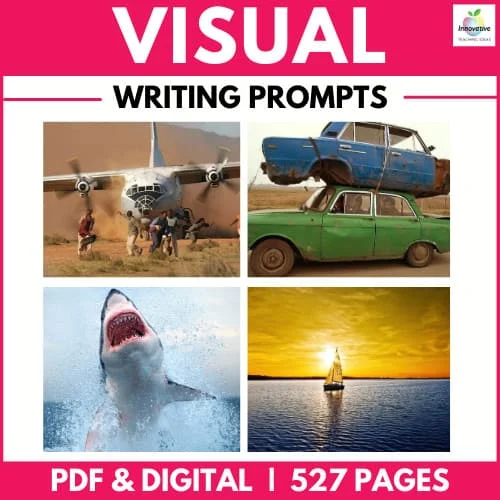
Tap into the power of imagery in your classroom to master INFERENCE as AUTHORS and CRITICAL THINKERS .
⭐⭐⭐⭐⭐ (26 Reviews)
This YEAR-LONG 500+ PAGE unit is packed with robust opportunities for your students to develop the critical skill of inference through fun imagery, powerful thinking tools, and graphic organizers.
Memory Writing Activities
While we want to avoid the cliched ‘ What I Did This Summer ’ essay, it doesn’t mean that memories of the long holidays can’t serve as an ‘ in’ to some worthwhile writing activities.
In the following writing activities, students will be asked to access their memories of summer to serve as a jumping-off point. Let’s get started!

Paint a Picture With Words
Essentially, this writing activity challenges students to write by employing their senses to evoke a memory.
First, ask the students to choose from a memory of a place they visited during the summer vacation. It doesn’t matter whether it’s a beach trip or a visit to a shopping mall; they’ll both serve equally well for this activity.
Students must then endeavour to recreate the scene as they recall it through careful selection of vocabulary and description.
The main focus of this type of writing will be the use of sensory language. Students should meditate on what they saw, heard, smelled, tasted, and felt while in their chosen place.
Students should work to paint a vivid, multi-dimensional picture in the reader’s minds-eye. For this reason, they should choose a static memory, such as a scene they recall. This activity has more in common with landscape painting than with film-making. A plot is not required.
This activity allows students to hone their descriptive writing skills, which will help them improve their writing in many genres.
Haiku Writing Activity
As with the last activity, this type of poetry is typically focused on evoking a scene. In the case of the haiku, this is usually a natural scene.
Before putting pen to paper, be sure students are suitably familiar with the features of the haiku:
- It consists of 3 lines
- It contains 17 syllables
- The 1st and 3rd lines have 5 syllables and the 2nd line has 7 syllables
- It does not need to rhyme
- It’s usually about nature or a natural phenomenon
- Often has two contrasting or juxtaposed subjects woven into it.
This activity is best introduced by reading and examining a couple of well-written haikus, such as those by Basho in translation, to ensure student familiarity with the form.
This is a very meditative writing form. It is essential to set a suitable mood and atmosphere in the classroom to encourage the necessary concentration and reflection the writing process will require. Playing gentle instrumental music is one way to help achieve this ambience.

Fun Back To School Writing Activities
While the first of our Back to School Writing Activities focuses clearly on breaking the ice and drawing on memories, the primary focus of the following writing activities is on having fun.
These activities will also offer students opportunities to develop some technical aspects of their writing skills; the main emphasis here is on students seeing writing as a fun, creative activity where they have the space and time for self-expression.
Don’t forget to read our complete guide to Fun Writing activities here.

Creative Excuses Writing Task
To start this activity, students must devise a list of 10 chores or tasks they absolutely hate doing.
Next, students should choose four from this list of their most detested tasks and write a letter explaining why they cannot complete them.
Encourage students to get creative with their excuses. The crazier and more imaginative the excuses are, the better. This activity is an opportunity for students to let their imaginations loose.
‘What If?’ Writing Prompts
Writing prompts are an excellent way for students to break through writer’s block. In this activity, students generate their own writing prompts by creating ‘ what if? ’ scenarios for other students in the class to use as writing prompts.
Many of the best and most creative stories start with an inquiry into what would happen if x happened. These scenarios can be silly, serious, fantastical, or humorous if they provide a jumping-off point for the student writer.
When students have completed their prompts, the teacher should gather them to distribute randomly among the class.
Students can share their work with the class When they have finished writing their responses to their assigned prompts. This will be especially interesting for the writer of the original prompt.

The Book Of Summer
This writing activity is an upgrade from the “My Summer Vacation” type essays.
In this activity, each student will compile their Book of Summer, describing and depicting their holidays using as many different writing genres as possible.
For example, the student might include the following in their Book of Summer:
- A non-chronological report on a day trip
- A comic strip based on a family celebration
- A review of a movie they saw or book they read
- A fictionalized account of their summer
- A recipe of a meal they made
- A playscript for a sleepover they went on
- A haiku on the end of summer
The scope for creative interpretations here is almost endless.
For younger students , it may be best to be more prescriptive about the various genres to include and the titles for each piece.
But for students with the ability, the open-endedness of this task allows their creativity to run loose while affording you a valuable opportunity to see just what they are capable of.
Be sure to read our complete collection of back-to-school writing activities.
Fictional Interviews Writing Task
This activity involves a little bit of writing and a lot of role-playing.
In this activity, students should be paired up with a partner. Each partner chooses a fictional character they will role-play. The character can be from any fiction, for example, movies, comic books, or literature.
Partners must prepare and write up a series of interview questions for their partner’s fictional character.
Partners take turns interviewing each other while the interviewee is in character.
This is a great way to bring a bit of drama into the classroom, but if you want to emphasize the writing aspect of the activity, you can set the students up for the interview in the style of a magazine feature article. This will require the student to weave some narrative writing around the back and forth of the questions and answers of the interview.

Write A Story From A Different Point Of View
Narrative writing requires competency in a broad range of complex skills . We can roughly divide those skills into structural ones (such as text organization) and language-related skills (such as sentence construction and creativity).
Getting your students to write a story is a great way to assess their abilities in these areas.
In this activity, however, you provide most of the structure for the student, giving them the space to exercise their imagination and a chance to focus on their grammatical control – among other things.
In this exercise, ask your students to select a favourite fairy tale or other traditional story they know well. The student’s task is to rewrite their favourite fairy tale from the point of view of another important character in the story.
For example, they might want to retell the Jack and the Beanstalk story from the point of view of the Giant or Jack’s mother.
Retelling The Ugly Duckling , the student might want to write from Mother Duck’s perspective to explore her feelings about the runt of her litter suddenly transforming into a beautiful (if alien!) swan
Summer Headlines Writing Activity
Headlines are fun to write .
They should be short and pithy, seizing the reader’s attention by telling them just enough about the story to pique their interest but still leave them wanting to read more.
There are several things that students can do to ensure their headlines have the desired effect, including:
- Choose powerful words designed to make an impact
- Use alliteration to create catchy, snappy headlines
- Employ humour to entertain and intrigue the reader
- Create suspense by posing the headline as a question
For this activity, students should list the main events of their summer break and create a headline for each event.
In this way, the students will have produced an account of their summer written entirely in headlines.
As an extension to this exercise, when they’ve finished producing their headlines, have them present them to the class or in smaller groups.
The best headline is selected from each list, which the student has to turn into a complete newspaper-style article on that event.

Rap and Verse Writing Task
Few genres of writing can be as divisive.
Some are dismayed by the mere mention of the word ‘poetry’ – The “ Why can’t poets just say what they mean? ” camp.
Then, some can barely write a shopping list without a bit of unnecessary versifying.
Love it or loathe it, poetry is on the curriculum and our students need to get to grips with it.
For this activity, students write a series of poems inspired by the events of their summer holidays. Essentially, they are writing a poetic account of their vacation.
To challenge the students, they must use a different type of poetry for each event they wish to retell.
For example, they might write a series of haikus on the weather during the summer break.
Perhaps they’ll produce a calligram or shape poem describing the treehouse they made.
Maybe they’ll write an elegy to a pet that died or a limerick on that disastrous camping trip.
They might like to use the headlines from the previous activity A Summer in Headlines as starting points for their poems.
By the end of this activity, your students will have a collection of self-authored poetry they can share with the class in the form of a poetry slam.
You may wish to provide your students with checklists of the various features of the different types of poetry to help them during this activity.
So, there we have seventeen engaging activities to kick start the writing process at the start of the school year.
There is quite a variety from here, with some activities honing technical aspects of the writing process while others are more centred on the fun of creativity.
Remember, at the start of the school year, what the students write isn’t so important, but what they write!
With the selection of activities above, you’re sure to find one to suit even the most pen-shy students!
Daily Quick Writes For All Text Types

Our FUN DAILY QUICK WRITE TASKS will teach your students the fundamentals of CREATIVE WRITING across all text types. Packed with 52 ENGAGING ACTIVITIES
OTHER GREAT WRITING ACTIVITIES TO TRY

7 Evergreen Writing Activities for Elementary Students

10 fun writing activities for the reluctant writer

13 Fun Reading Activities for Any Book
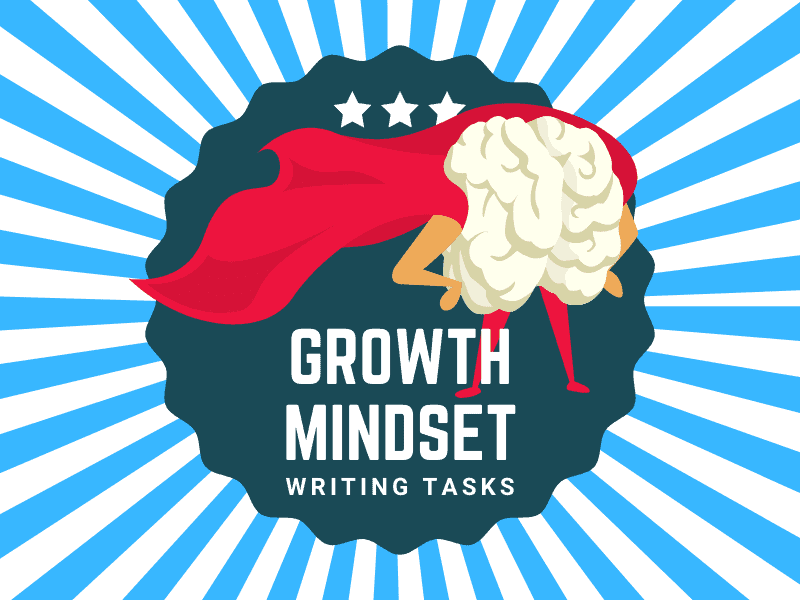
5 Fun Growth Mindset Writing Activities Students and Teachers Love

6 YouTube Writing Activities for Students and Teachers
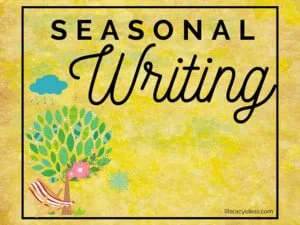
5 Fun Seasonal Writing Activities Students and Teachers Love

IMAGES
VIDEO
COMMENTS
Examining Elements of Creative Writing in First Grade. For this particular unit, my first grade students were examining literature and storytelling. After they had enjoyed several read-alouds, explored story elements, and studied the story mountain (beginning, rising action, conflict, resolution, and ending) as a team, it was time for them to ...
These first grade writing prompts are great to spark your imaginations and get students writing! ... Grades Grades. All Grades K-5 All Grades 6-12 PreK 6th Grade Kindergarten 7th Grade 1st Grade 8th Grade 2nd Grade 9th ... Administrator Professional Development Assessment Back to School Creative Classroom Education Resources End of School Year ...
47 Fun and Easy First Grade Writing Prompts. 35 Fun and Easy Writing Prompt Ideas for First Graders + 12 BONUS Prompts — After spending a year in kindergarten balancing the importance of play with the basics of life in the classroom, first grade students are ready to begin reading and writing in earnest. Oh yeah. You see….
These first grade writing prompts can inspire your students to get their creative juices flowing. Explore these writing topics to try in your classroom. ... You get to choose an adventure for your whole class. What do you pick? An adult in your family has to go to first grade for a day. What happens? ... From these fun 1st grade writing prompts
In these wonderful writing prompts for first grade students, your class will make great use of their imaginations and creative spirits. So get to it and use these writing prompts for first-grade students today to help them learn how to express their opinions and ideas through journaling. 37 Writing Ideas and Prompts for First Graders
The top writing ideas for 1st grade students can involve describing events, objects, narratives, and storylines, giving them more control on their vision for their answers. You can use these creative writing prompts 1st grade level questions at any time during the year. 1. Describe a dream walk through a garden. 2.
First Grade Writing Worksheets. First graders are tasked with improving their written vocabularies, writing more detailed sentences, and crafting short narratives. Our first grade writing worksheets encourage your child to build upon her literacy foundation with writing prompts, sentence completion practice, story maps, and more.
Our first grade writing prompt and story writing worksheets will inspire your little bards to get creative and write their own stories! Through interactive and engaging activities, your students will use their sentence writing skills to create complete narratives. Practice organizing ideas, writing descriptively, and brainstorming with story ...
To keep things fun and exciting, take a look at our printable writing pages. So get to it and use these 30 narrative writing prompts and topics for 1st grade students to help your kids learn about the basic elements of storytelling! Until next time, write on…. please share them on Facebook, Twitter, and/or Pinterest.
25 Wonderful Writing Prompts for First Graders. December 4, 2023 by Sohaib Hasan Shah. The journey of a young writer begins with a single spark of imagination. As adults, we know the magic that words can bring to our lives, and fostering this magic in children is a gift that lasts a lifetime. First graders are at an age where their minds are ...
Monkey Business. Students write their own story about Curious George. Browse our printable 1st Grade Creative Writing Worksheets resources for your classroom. Download free today!
Here are writing topics to encourage students to give detailed instructions on doing something or practice writing a description. Explain how to brush your teeth. 2. Write directions on how to play your favorite game. 3. Give steps on how to wash your hands. 4. Write three things you did before coming to school. 5.
Bookmaker. Turn your child's writing into books! Paste her drawings and writings on pieces of construction paper. For each book, make a cover out of heavier paper or cardboard, and add special art, a title, and her name as author. Punch holes in the pages and cover, and bind the book together with yarn or ribbon.
Creative Writing worksheets for Grade 1 are an excellent resource for teachers looking to engage their students in the world of fiction writing. These worksheets provide a variety of activities that help students develop their reading and writing skills while fostering a love for storytelling. By incorporating different elements of fiction ...
List. Teaching students to free-associate and generate a list of things they are thankful for is a fun way to help your class…. Browse our printable 1st Grade Creative Writing Lesson Plans resources for your classroom. Download free today!
If they are left handed especially, let them hold their paper however they want to. You want their focus to be as much on their writing as possible and limit any distractions, frustrations, and discomforts in order to make writing as fun as possible. 4. Let your students write about topics they're interested in!
Lesson Plan. Plan Your Story: Sequence of Events. Lesson Plan. St. Patrick's Day Writing: If I Found a Pot of Gold... Lesson Plan. Play With Punctuation. Lesson Plan. 1. Encourage your first graders to sharpen their literacy skills, build their vocabulary, expand sentences, and practice grammar with these lesson plans.
Teachers and parents can also show children the "invented spelling" strategy of saying a word slowly, stretching out the sounds, and printing a letter (or letter combinations, such as "th ...
Creative Writing worksheets for Class 1 are an excellent resource for teachers looking to engage their students in the world of fiction writing. These worksheets provide a variety of activities that help students develop their reading and writing skills while fostering a love for storytelling. By incorporating different elements of fiction ...
8 fun Grade 1 writing activities. We've compiled a list of seven exciting writing activities to inspire your little ones to get started on their writing journey. 1. Read, Read, Read! Your first-grade child may have a book that they just love! Why not get them to read it one more time and then write a short paragraph explaining why they love ...
Examples of Creative Writing For Class 1: 1. Write a story about a magical forest. Once upon a time, there was a magical forest. The trees were tall and covered in green leaves. The animals that lived in the forest were friendly and happy. One day, a group of children went into the forest to explore. They soon discovered that the forest was ...
17 Fun First Day Of School Writing Activities. By Shane Mac Donnchaidh July 23, 2021April 1, 2024 April 1, 2024. The smell of freshly painted halls, the excited chatter of returning students bursting with two months' worth of gossip to share—it must be the first day at school again. Rusty pens and dusty pencils are hastily pulled from the ...
Here you'll see 15 fabulous first day of school writing activities — This list of ideas is packed full of fun and engaging ways to interact with the new group of kids in your classroom. Plus, you'll find nine first day of school writing ideas, twelve new school year resolutions, 8 ice breakers, and 5 school success tips. Oh yeah….